Music is the universal language
“Glory to God in the highest heaven, and on earth peace to those on whom his favor rests.” - Luke 2:14
Premier Guitar
Electro-Harmonix Oceans Abyss Review
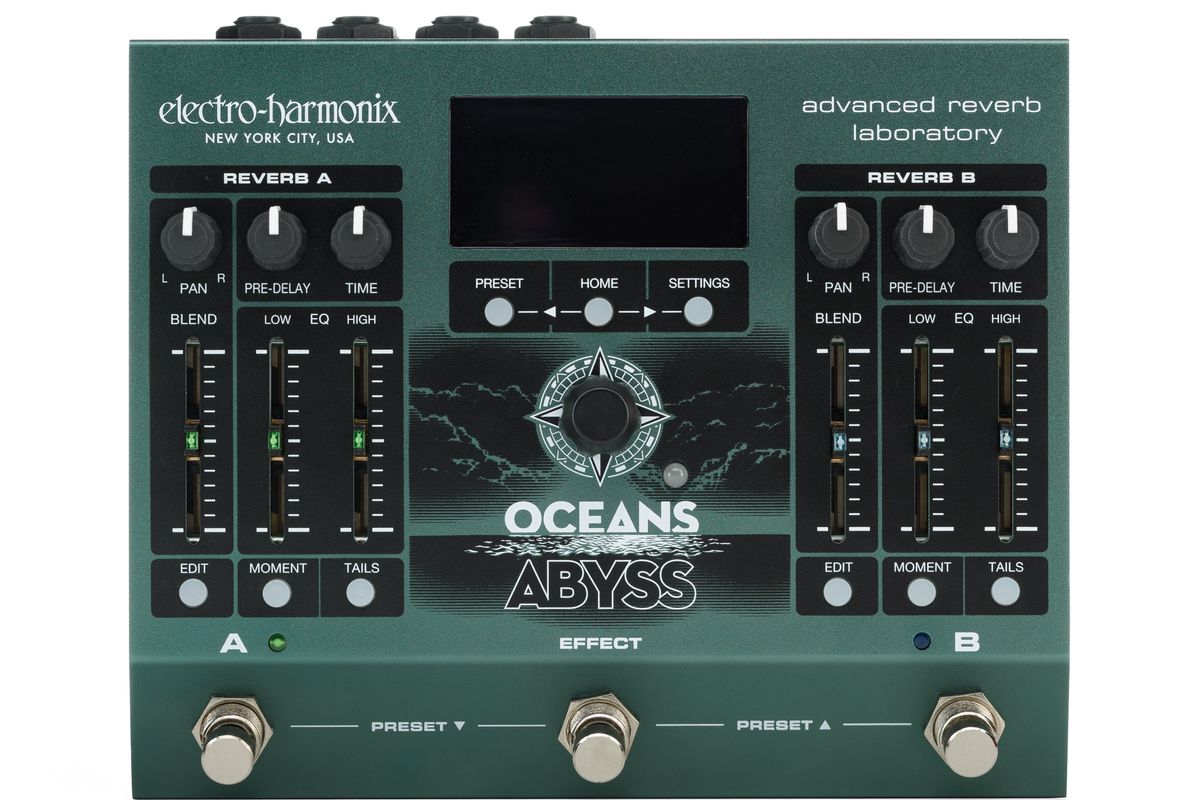
Abyss is right. Electro-Harmonix’s Ocean’s Abyss, with two stereo reverbs and 10 reverb types, is fundamentally a reverb pedal. But it is deeper than that. Much, much deeper. EHX calls the Abyss an Advanced Reverb Laboratory. I’d venture that it is more like a reverb-centric multieffects unit, because the Oceans Abyss enables you to add effects that include chorus, distortion, delay, and bit-crushing to the expansive array of reverbs. But I’m not even sure my modified description does the pedal justice. It is a sound-design machine of impressive power—especially if you have the time and will to explore the breadth of its functions.
For a pedal that makes so many sounds, the Oceans Abyss’ control layout is fairly straight ahead, and compared to some of EHX's other superpedals it’s actually downright economical. The center screen displays a virtual pedalboard where you can manipulate effects and signal routing via a control knob and just a few buttons. The reverb controls themselves, meanwhile, are easy to tailor via a knob-switch-and-slider array that enables adjustment of effects blend, EQ, pre-delay, reverb time, pan position in a stereo field, and more. The input/output array is capable but straightforward, with stereo I/O, effects send and return, plus MIDI, USB, and expression-pedal capability.
Deep Diving
The individual reverb sounds in the Abyss are excellent, which, given my experience with previous Oceans-series reverb pedals, is what I would expect. The more complex factory presets range from weird-but-inspiring to verging on impractical. But the simpler reverbs exude elegance. Even the other built-in effects are incredible. I got delightfully lost in the bit crusher for some time, dialing in a very interesting and buzzy fuzz tone.
“The simpler reverbs exude elegance.”
The factory presets are great jumping-off spots and rewarding to use. But to take full advantage of the pedal’s capabilities—and, perhaps, to justify the lofty $495 price—you’ll need to spend significant time with the Abyss and its manual. Creating and editing presets (you can save up to 128) isn’t always intuitive. For many users, customization will be easier using the available desktop patch editor or the not-yet-available EHX patch editor app. Even power users may be hard-pressed to utilize all of the Abyss’ capabilities. I am anxious now, knowing that somewhere in my house the Oceans Abyss is flashing red—still signaling intolerance of my refusal to fully commit to a pre-delay time.
In name, function, and price, the Ocean’s Abyss is much more than its predecessor, Oceans 12. It’s seemingly infinite, endless in every direction. Whether it’s a fit for you will come down to your appetite for exploration and study, and the scale of your musical ambitions.
.rbm-pick-card { --rbm-border: #88e89e; --rbm-accent: #000000; border: 2px solid var(--rbm-border, #e53e3e); border-radius: 10px; padding: 16px; background: #fff; font-family: inherit; position: relative; } .rbm-pick-badge { position: absolute; top: -10px; left: 12px; background: var(--rbm-accent, #e53e3e); color: #fff; font-size: 12px; line-height: 1; padding: 6px 10px; border-radius: 6px; font-weight: 700; } .rbm-pick-wrap { display: grid; grid-template-columns: 110px 1fr; gap: 16px; align-items: start; } .rbm-pick-img { aspect-ratio: 1 / 1; /* forces square crop */ overflow: hidden; border-radius: 6px; background: #f3f4f6; /* subtle placeholder */ } .rbm-pick-img img { width: 100%; height: 100%; object-fit: cover; /* crops without distortion */ display: block; } .rbm-pick-title { margin: 0 0 4px; font-size: 20px; font-weight: 800; color: #111; } .rbm-pick-sub { margin: 0 0 12px; font-size: 14px; font-weight: 700; color: #334155; } .rbm-pick-btns { display: grid; gap: 10px; max-width: 560px; } .rbm-pick-btns a { display: block; text-align: center; background: #000; color: #fff !important; text-decoration: none; padding: 12px 14px; border-radius: 8px; font-weight: 800; letter-spacing: .3px; } .rbm-pick-btns a span.price { text-transform: none; } .rbm-pick-btns a span.label { text-transform: uppercase; } /* Responsive */ @media (max-width: 560px) { .rbm-pick-wrap { grid-template-columns: 80px 1fr; } .rbm-pick-title { font-size: 18px; } }
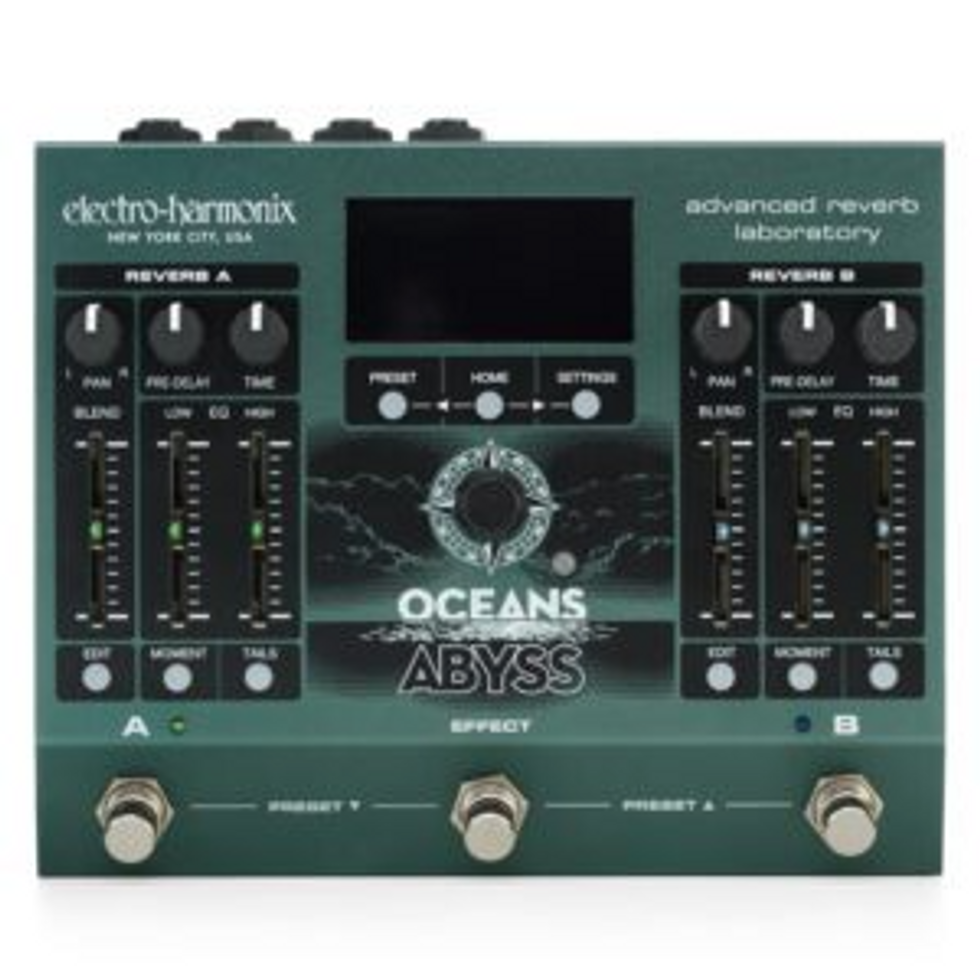
Electro-Harmonix Oceans Abyss Review
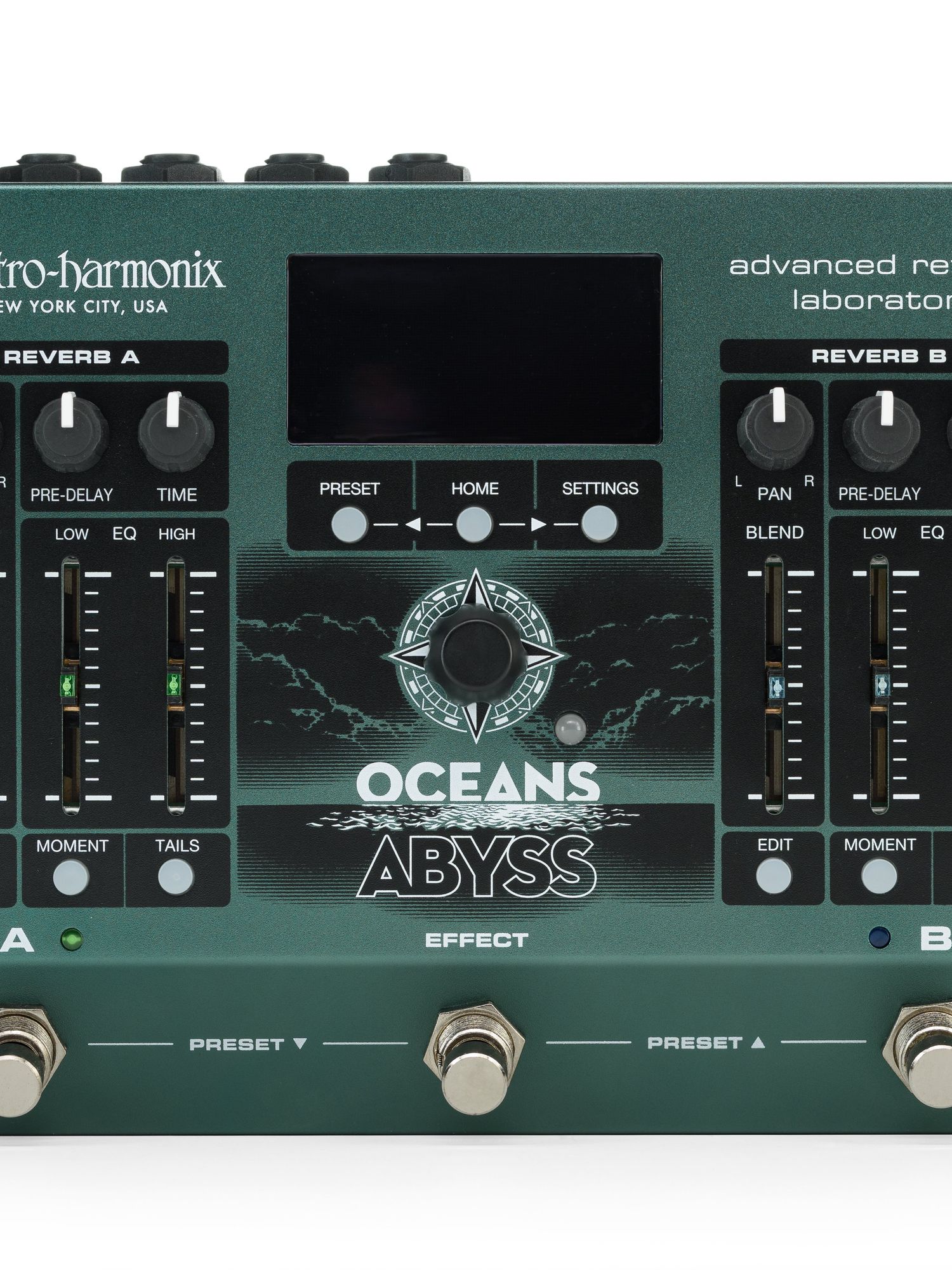
Abyss is right. Electro-Harmonix’s Ocean’s Abyss, with two stereo reverbs and 10 reverb types, is fundamentally a reverb pedal. But it is deeper than that. Much, much deeper. EHX calls the Abyss an Advanced Reverb Laboratory. I’d venture that it is more like a reverb-centric multieffects unit, because the Oceans Abyss enables you to add effects that include chorus, distortion, delay, and bit-crushing to the expansive array of reverbs. But I’m not even sure my modified description does the pedal justice. It is a sound-design machine of impressive power—especially if you have the time and will to explore the breadth of its functions.
For a pedal that makes so many sounds, the Oceans Abyss’ control layout is fairly straight ahead, and compared to some of EHX's other superpedals it’s actually downright economical. The center screen displays a virtual pedalboard where you can manipulate effects and signal routing via a control knob and just a few buttons. The reverb controls themselves, meanwhile, are easy to tailor via a knob-switch-and-slider array that enables adjustment of effects blend, EQ, pre-delay, reverb time, pan position in a stereo field, and more. The input/output array is capable but straightforward, with stereo I/O, effects send and return, plus MIDI, USB, and expression-pedal capability.
Deep Diving
The individual reverb sounds in the Abyss are excellent, which, given my experience with previous Oceans-series reverb pedals, is what I would expect. The more complex factory presets range from weird-but-inspiring to verging on impractical. But the simpler reverbs exude elegance. Even the other built-in effects are incredible. I got delightfully lost in the bit crusher for some time, dialing in a very interesting and buzzy fuzz tone.
“The simpler reverbs exude elegance.”
The factory presets are great jumping-off spots and rewarding to use. But to take full advantage of the pedal’s capabilities—and, perhaps, to justify the lofty $495 price—you’ll need to spend significant time with the Abyss and its manual. Creating and editing presets (you can save up to 128) isn’t always intuitive. For many users, customization will be easier using the available desktop patch editor or the not-yet-available EHX patch editor app. Even power users may be hard-pressed to utilize all of the Abyss’ capabilities. I am anxious now, knowing that somewhere in my house the Oceans Abyss is flashing red—still signaling intolerance of my refusal to fully commit to a pre-delay time.
In name, function, and price, the Ocean’s Abyss is much more than its predecessor, Oceans 12. It’s seemingly infinite, endless in every direction. Whether it’s a fit for you will come down to your appetite for exploration and study, and the scale of your musical ambitions.
MONO Releases the M80 Classic Ultra Gig Bag
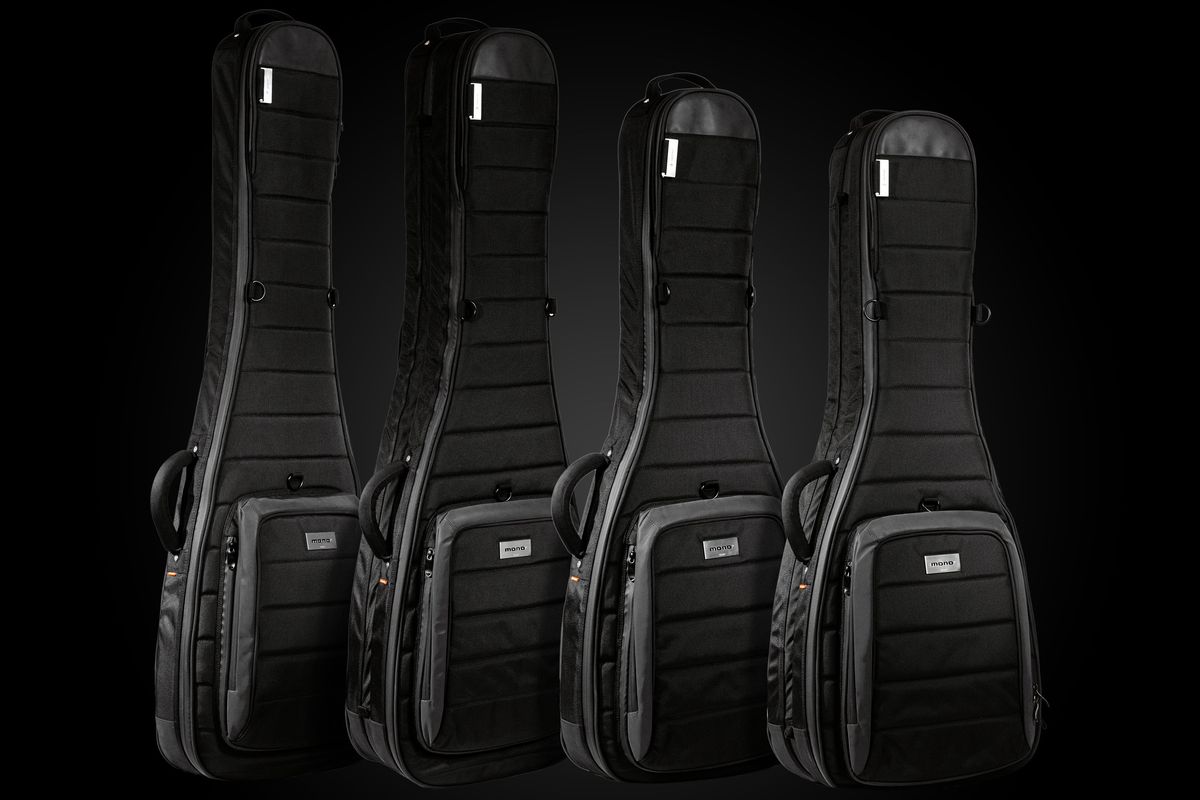
MONO has introduced the M80 Classic Ultra – the latest evolution of the company’s sleek, iconic gig bag, now enhanced with smarter storage, effortless mobility, and tougher protection.
Building on the innovation of the original M80, the Classic Ultra features a refined silhouette and thoughtful upgrades designed to make life on the move easier for gigging musicians, touring professionals, and everyday players alike.
At the core of the Classic Ultra is the patented Freeride® Wheel System, allowing users to attach wheels for seamless transport when navigating airports, sidewalks, or venues. The system is especially impactful on Dual models, lightening the load while moving two instruments at once. Storage has also been supercharged. A newly designed expandable front pocket offers more room for tools and gigging essentials, while built-in compartments help keep everything in place. For even more capacity, the Classic Ultra case is Tick-ready and compatible with the MONO Tick 2.0 and Tick+ 2.0 Accessory Cases.
Inside, the instrument is protected by the Headlock® neck suspension system, keeping it securely in place and shielded from impact. A discreet tracker tag-compatible pouch adds peace of mind for travel. The exterior is built tough with water-resistant 1680D ballistic nylon, waterproof zipper tape, and reflective strips for added safety.
Key Features of the M80 Classic Ultra:
- The patented Freeride® Wheel System allows users to seamlessly attach wheels to the case, providing smooth and effortless mobility.
- Expanded smart storage includes dedicated internal compartments and an expandable front pocket, offering ample space for tools and gigging essentials.
- The case is Tick-ready, fully compatible with MONO’s Tick 2.0 and Tick+ 2.0 Accessory Cases for even greater storage flexibility.
- The signature Headlock® neck suspension system keeps your instrument securely in place, now enhanced with a discreet pouch designed to hold a tracker tag.
- The durable exterior is constructed from water-resistant 1680D ballistic nylon and features waterproof zipper tape and reflective detailing for added protection and visibility.
The Classic Ultra is available in versions for guitar, bass, dual guitar, and dual bass, ensuring a fit for every player’s needs.
The MONO M80 Classic Ultra carries street prices of $359.99 (Guitar/Bass) and $459.99 (Dual Guitar/Bass) and is available via monocreators.com and select authorized dealers worldwide.
Aclam Go Rocky Go Review
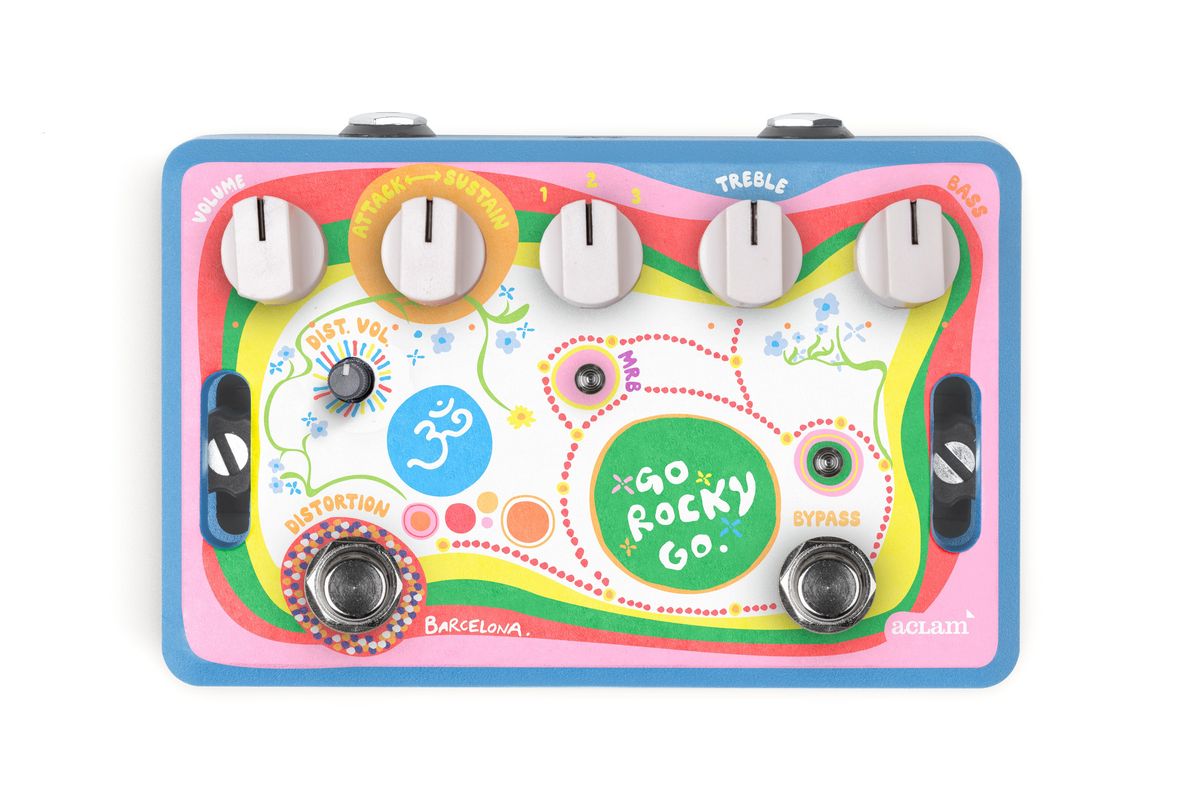
In electric guitar terms, I’ve always thought the Beatles are pretty underrated as tone meisters. We all know how good the records sound as complete works. But you rarely encounter rabid enthusiasm for the guitar tones themselves. Holy cow, though, I adore them. The electric tones that shape their 1966-’68 LPs are among the most beautiful, thrilling, and influential forces in my life. Barcelona company Aclam shares my sentiments, apparently. To date, the company built the Dr. Robert, which honored the sounds of the Vox UL730s on Revolver and Sgt. Pepper, and the Mocker, which aped the fuzz circuit from that amp.
Aclam’s latest, the Go Rocky Go, pays homage to another Vox amp that graced Abbey Road in those groundbreaking years: the Conqueror. The Conqueror left a less distinct, less well-chronicled mark on the Beatles' work than the UL730s or UL7120s. But it was definitely a part of The Beatles recording sessions (you can clearly hear the amp’s “MRB” selector at the end of “Birthday”) and is the likely source of many sounds on Magical Mystery Tour. Aclam’s Go Rocky Go dishes many fantastic Conqueror tones, and it’s dripping with psychedelic-era Beatles-ness—especially if you enjoy the more aggressive and distorted sounds from that period.
Magical Mystery Re-Routes
Aclam say they reproduced the Conqueror’s preamp topology part-for-part using an original Conqueror specimen (serial number 2004) as reference. With the MRB switch and distortion, they recreated much of the Conqueror’s functionality. There are a few significant differences, however. Aclam recreated the 2-channel amp’s brilliant channel exclusively. They added a second gain stage called the crunch channel, which splits the difference between the standard and distortion channel’s gain profiles. Aclam also made the bass pot more linear and precise than the amp’s. And unlike the Conqueror, the distortion circuit has its own output-level control.
Heavy Tripping the Light Fantastic
Though the Go Rocky Go will summon compelling tones from any guitar/amp combination, its basic voice is a natural fit for humbuckers and an EL84 amp. And depending on where you set the tone controls, it adds midrange focus and top-end running from sparkly to vicious. Black-panel Fender amps are less easily flattered by the humbucker/Rocky combo, but those tones can be carved into very precise, high-mid rhythm and lead sounds. With Fender single-coils, too, EL84s are a more organic match, but I’d be psyched to record with many of the hyper-focused high-mid sounds from the Go Rocky Go and a Fender guitar-and-amp pairing.
Adding the MRB switch to the mix (by pressing both footswitches) boosts either the 500, 700, and 1k MHz frequencies, just like three positions on a wah. Ostensibly, this narrows the pedal’s range. But the single-coil/Rocky tones with both Fender and EL84 amps are fascinating, generating sounds that would positively pop in mixes. Humbuckers seemed to summon the best from the MRB settings in both amp types—coaxing uniquely focused and burly midrange tones.
“You might think you know this distortion from Beatles records, but in the flesh it’s something much more substantial.”
Given the Beatles’ legacy as masters of pop, it’s easy to forget how tough they could be, and the Go Rocky Go gleefully, colorfully embodies that facet of the band’s personality in the distortion section. With any guitar and amp combination these sounds are snarly, nasty, and biting, but also massive. You might think you know this distortion from Beatles records, but in the flesh it’s something much more substantial. And while 6L6- or EL34-type distortion might be more even and full-spectrum in harmonic terms, the Go Rocky Go delivers a wicked, room-filling punch.
For a specialized pedal, $348 is a big investment. Listen with open ears and mind, though, and you’ll hear scads of different and brilliant tone colors in this stomp, including many that—surprise!—would benefit and intrigue curious and intrepid studio artists. In my humble opinion, Go Rocky Go is a ripper. But ’66-’68 Beatles tones may not be everyone’s ideal, and though often muscular and hard-hitting, they dwell some distance from Marshall or Fender archetypes. That, however, is the beauty of the Go Rocky Go, and if it’s good enough for the Fabs, it’s good enough for me.
PG's Editorial Director Reflects on His Decade at the Magazine
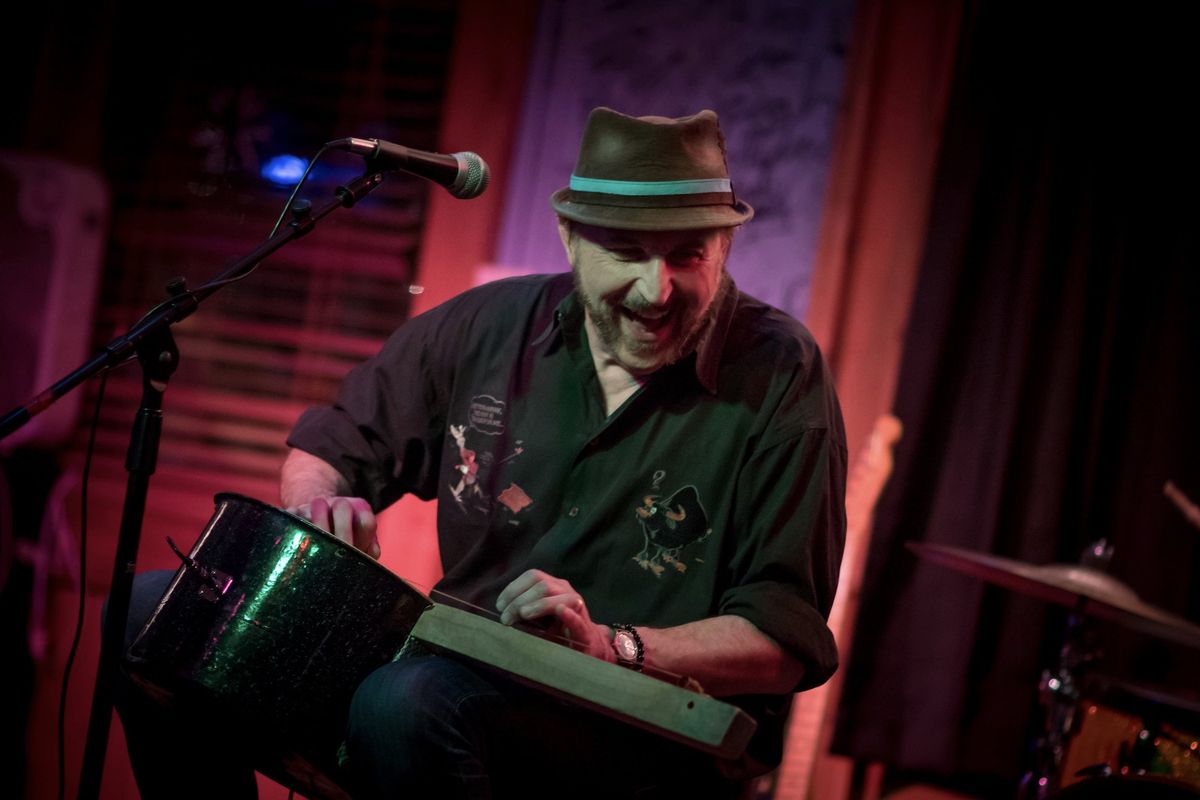
Ted Drozdowski considers his time at his favorite guitar magazine, his life in music and journalism, and what the future holds as he retires.
I’ve truly enjoyed sharing stories and ideas with you these past few years, and value the time I’ve been able to spend with every member of the Premier Guitar community. But—even though horses make me a little anxious—it’s time to ride on down the road. Not into the sunset, though. You can expect to see my byline in future issues and still drop me a line at my email address here. Or you can connect with me on social media and join me in my creative exploits, where I will continue to chase music and the adventures it brings.
I’ve been at Premier Guitar for a decade now, and have served as editorial director for most of the past three years, so this decision doesn’t come lightly. I’ve been able to do a lot of work here that I’m proud of, from interviewing artists ranging from Carlos Santana to the Messthetics, to writing odes to personal heroes like R.L. Burnside and Sonny Sharrock, to gently guiding the magazine in a direction that I hope has served you well and will continue to do so under the leadership of my colleague and friend Richard Bienstock. Rich and I met when I was writing for him at Guitar World and Guitar Aficionado years ago, and more recently he’s taken to writing for us here at PG. The wheel turns. Rich is an exceptional editor and I know you will enjoy what he brings.
“You can never have enough friends in this life. And the ones who inspire and encourage you are especially precious.”
Will I miss feeling the pulse of exciting new gear and music on a daily basis? Sure! But after 47 years as a music journalist, I won’t miss the perpetual deadlines—or the tyranny of the alarm clock! I have a long list of personal musical projects to shepherd and pursue—most prominently the feature film The River: A Songwriter’s Stories of the South, which I made with my cosmic roots band Coyote Motel. It’s a psychedelic musical cultural history that is plucked from the pages of my interests and life over the past 30 years. In a final shameless plug within these pages, it is available on several streaming outlets now and as a DVD, and I urge you to satisfy any curiosity you might have about me and my musical interests—think David Gilmour and Sonny Sharrock meeting R.L. Burnside, the Band, and Son House at the intersection of highways 61 and 49.
Speaking of community, which I value greatly, one of the most wonderful things my time at PG has allowed me to do is reconnect with guitarists and other musicians I’d fallen out of step with during the years I was breathlessly freelance writing and ripping around the U.S. and parts of Europe with my earlier bands. Like touring, it’s also allowed me to make many wonderful new friends, from readers who‘ve exchanged emails with me and come to my gigs (you know who you are—thank you!) to artists whose art and personalities have inspired and delighted me, and with whom I’ve grown close. That is certainly something that I hope continues, because you can never have enough friends in this life. And the ones who influence and encourage you are especially precious.
Finally, I’d like to compliment my colleagues in every department of this magazine. They are a tight-knit bunch with myriad skills, and it’s been a pleasure working with them. Many of them are damn fine guitar players, too. Premier Guitar is not part of an international publishing conglomerate. It is an independent business that has stood the test of time, the challenges of Covid, and now the economic uncertainties that each day’s headlines seem to bring. It’s been an honor, my friends—and for me, a beautiful way to bring my journalism career to a crescendo. Although, once again, not a finale.
Now, if you’ll excuse me, I’m heading to the beach.
Fender Partners With Third Man, Unveiling Accessories & Apparel Collection
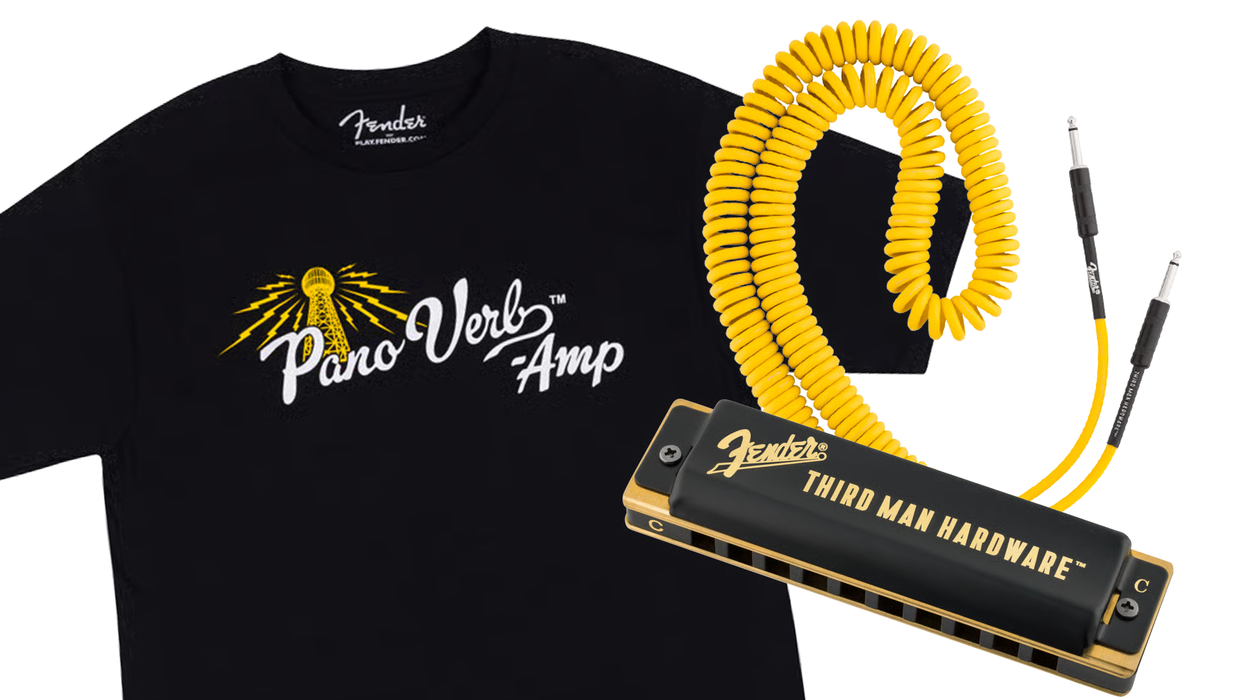
Inspired by Third Man’s raw, gritty aesthetic and strikingly vibrant yellow-on-black colour palette, the Fender x Third Man Hardware Collection embodies the unmistakable style that has defined Jack White’s artistry from his time as founder of the White Stripes, all the way through to his work with The Raconteurs and The Dead Weather and more recently, his ventures as a solo musician.
With products ranging from a tee and hoodie to a gold-etched harmonica and Mini Jack Rack inspired by the Pano Verb™ Amp, the collaboration showcases Jack White and Third Man’s boundary-pushing creativity and innovation.
“Our co-branded apparel and accessories collection brings a vintage flair that speaks to Jack White’s storied legacy and continued creativity,” said Jordan Gruver, Senior Product Manager of Accessories at Fender. “It’s been a pleasure tapping into Third Man’s bold image to create a collection that amplifies the timeless appeal and vibrant style of the iconic label and record store.”
“This collaboration with Fender is more than just accessories — it’s a meeting of legacy and style,” said Christina Inman, Director of Merchandising at Third Man Records. “Third Man Hardware is proud to inject our signature style and look into tools that speak to the hands of creators everywhere.”
Fender® x Third Man Hardware™ Mini Jack Rack
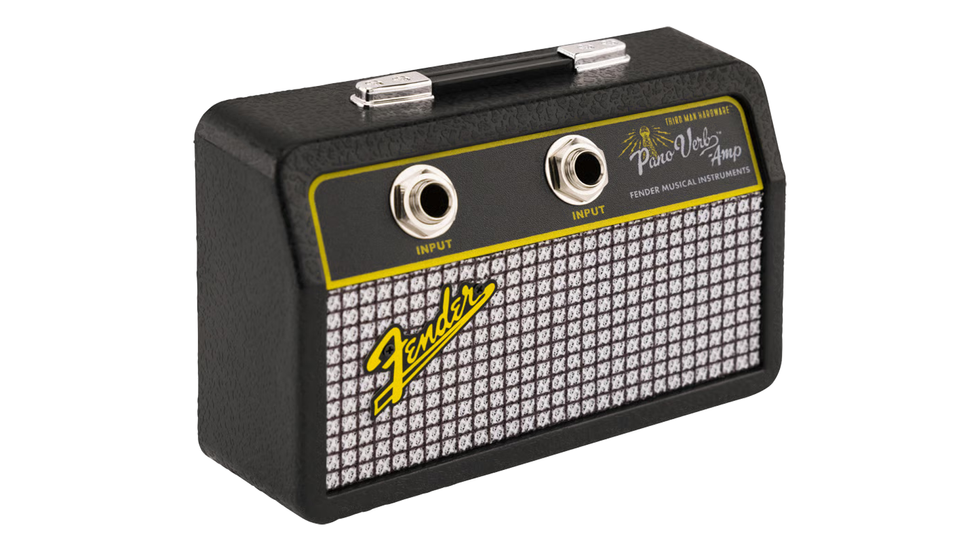
($29.99, €39.99 EUR, £33.99 GBP, $49.00 AUD, ¥4,950 JPY)
The Thirdman Hardware™ Mini Jack Rack is wall-mounted and turns your keychain into part of your rig. Comes with real 1/4” input-style keychains that plug in just like a guitar cable – perfect for the studio, the jam room, or anywhere you want a little more tone in your home.
Fender® x Third Man Hardware™ Lapel Pin Set
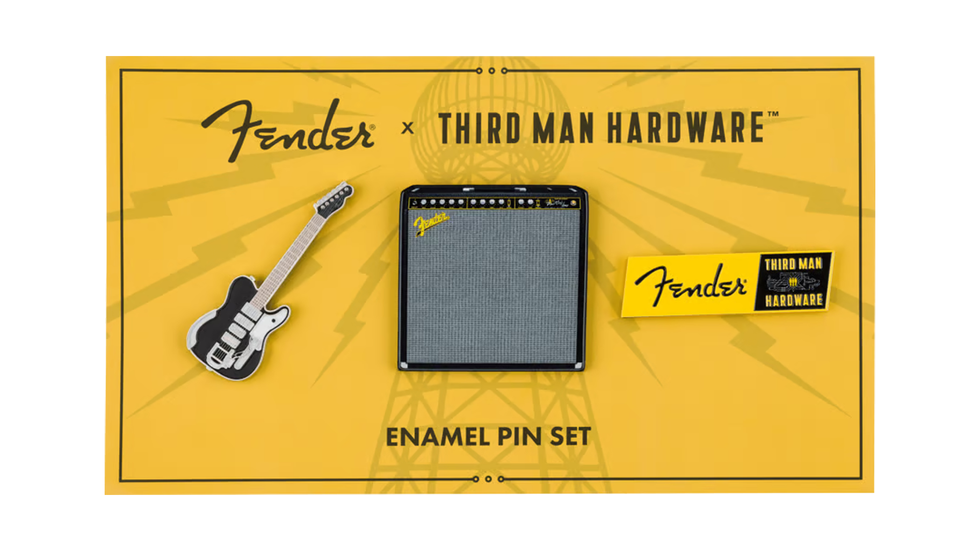
($24.99, €28.99 EUR, £23.99 GBP, $45.00 AUD, ¥4,180 JPY)
The Thirdman Hardware™ Lapel Pin set brings the raw, analog energy of Fender® and Third Man Hardware™ into your everyday fit. Featuring bold designs inspired by the iconic Pano Verb™Amp and signature Jack White Triplecaster™Telecaster®, these pins are built for fans who live and breathe the sound.
Fender® x Third Man Hardware™ Leather Strap
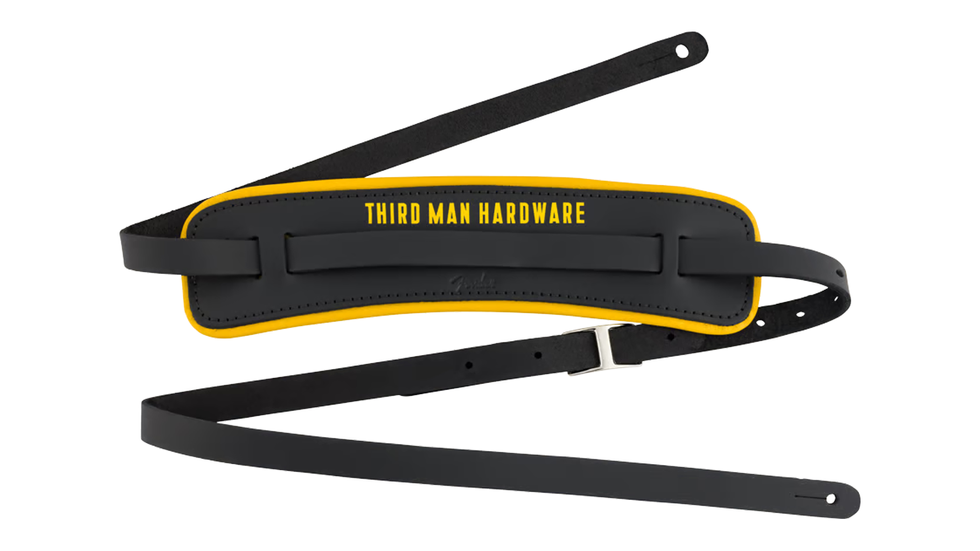
($59.99 USD, €66.99 EUR, £55.99 GBP, $110.00 AUD, ¥8,800 JPY)
Add retro-inspired style to your guitar with the Fender® x Third Man Hardware™ Leather Strap. Made from premium full-grain leather, this 2.5” wide strap features ample padding for maximum playing comfort. Drawing inspiration from Third Man’s iconic aesthetic, the strap’s bold yellow trim and Third Man Hardware logo deliver a vintage flair and timeless appeal. Whether you’re on stage or in the studio, this strap brings a touch of Jack White’s legendary look to your performance.
Fender® x Third Man Hardware™ Harmonica
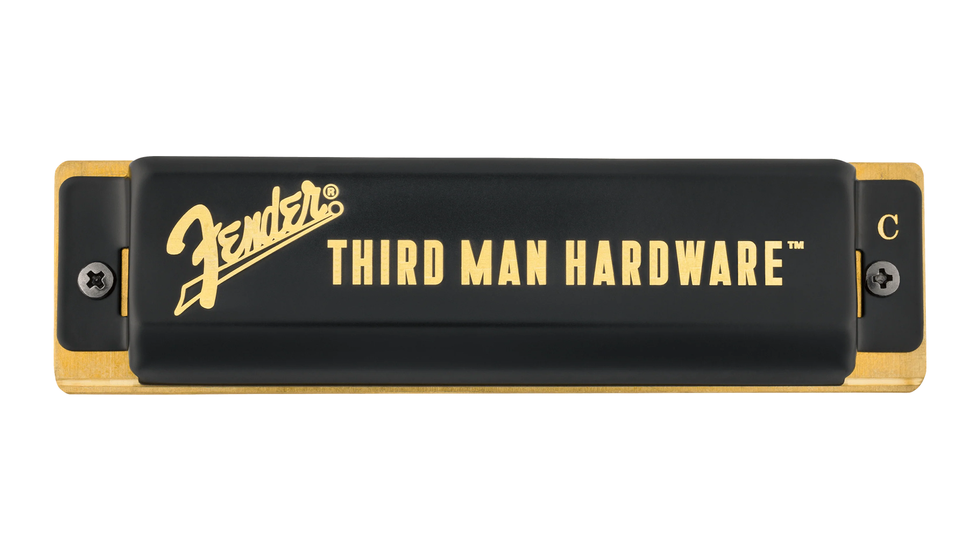
($ 41.99 USD, €47.99 EUR, £39.99 GBP, $85.00 AUD, ¥7,700 JPY)
Add retro-inspired style to your sound with the Fender® x Third Man Hardware™ Harmonica. Designed for everyday players, this 10-hole diatonic harmonica features phosphor bronze reeds for bright, bold tone and a moisture-resistant ABS comb for long-lasting reliability. Drawing inspiration from Third Man’s iconic aesthetic, its sleek gold-etched casing, and Third Man Hardware logo deliver vintage flair and timeless appeal. Bring a touch of Jack White’s legendary look to your performance with the Fender x Third Man Harmonica.
Fender® x Third Man Hardware™ 30’ Coil Cable
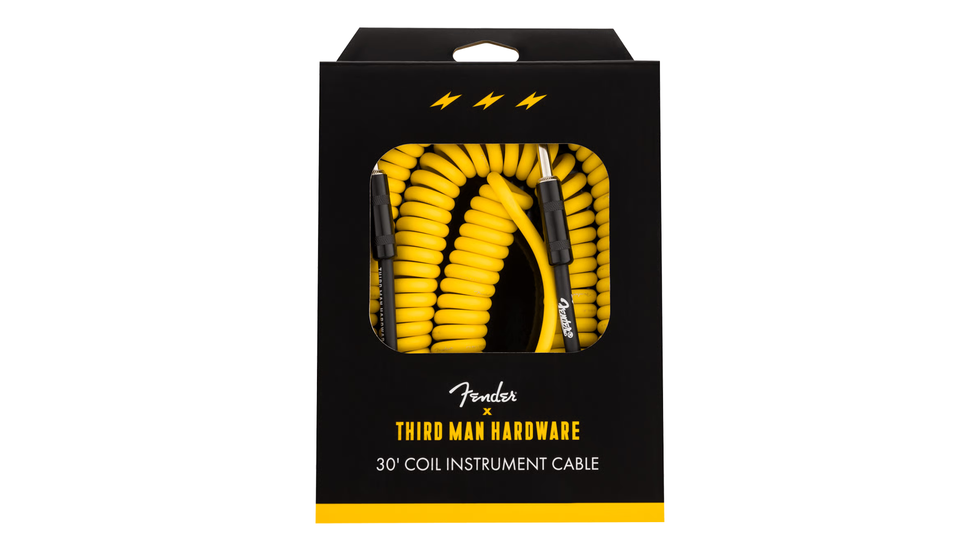
($62.99 USD, €51.99 EUR ,£43.99 GBP, $125.00 AUD, ¥6,600 JPY)
The Fender® x Third Man Hardware™ 30’ Coil Cable combines high-performance design with retro-inspired style. Featuring spiral shielding and durable nickel-plated connectors, this cable delivers reliability in the studio or on stage. Drawing inspiration from Third Man’s bold aesthetic, the cable features a striking yellow PVC jacket and custom ends featuring the Third Man Hardware logo, adding a vintage flair to your setup.
Fender® x Third Man Hardware™ Strap Blocks
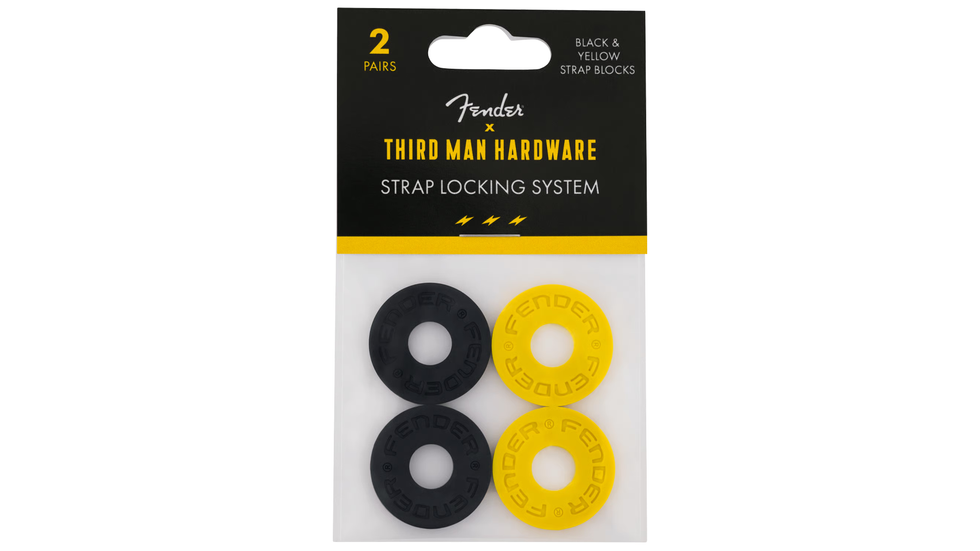
($5.99 USD, €9.99 EUR, £7.99 GBP, $8.00 AUD, ¥880 JPY)
The Fender® x Third Man Hardware™ Strap Blocks deliver the ultimate in strap security with unmistakable style. The most reliable and hassle-free instrument strap lock system ever devised. No need to remove or replace existing strap buttons on your guitar; just slip a Strap Block over the existing strap buttons and that’s it - you’re ready to go, with your strap locked securely in place.
Each package includes two complete sets: one in classic black and one in bold yellow, giving you the freedom to mix, match, or outfit two Instruments.
Fender® x Third Man Hardware™ Tee
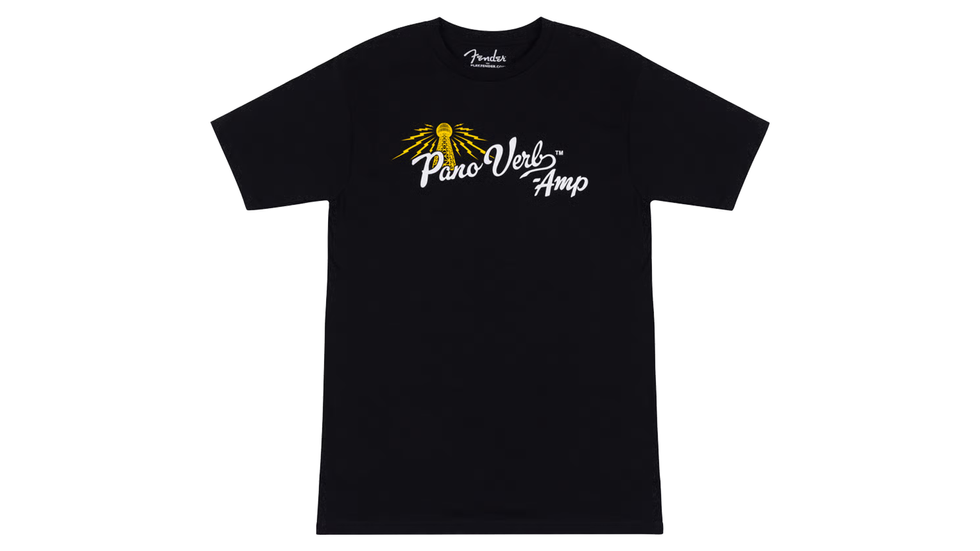
($31.99, €32.99 EUR, £27.99 GBP, $49.00 AUD, ¥6,600 JPY)
Third Man Hardware™ and Fender® join forces on this standout tee, showcasing the notable Pano Verb™ Amp graphic up front and a co-branded logo across the back. Built for the stage, the street, or the studio. Sizes: S – XXL
Fender® x Third Man Hardware™ Hoodie

($72.99 USD, €73.99 EUR, £61.99 GBP, $110.00 AUD, ¥13,200 JPY)
Third Man Hardware™ and Fender® join forces on this standout hoodie, showcasing the notable Pano Verb™ Amp graphic up front and a co-branded logo across the back. Built for the stage, the street, or the studio. Sizes: S – XXL
Testament Announce New Album Para Bellum + Release Music Video For 'Infanticide A.I.'

Bay Area thrash metal icons TESTAMENT returns this Fall with their fourteenth studio album, Para Bellum. The album which will be released on October 10th via Nuclear Blast Records stands as both a battle cry and an observation of humanity's uneasy alliance with its own creations. As technology accelerates and disconnection grows, Para Bellum sees TESTAMENT reflecting the modern chaos through music that’s urgent, sharp, and unflinchingly human.

Today, TESTAMENT deliver one of their most intense songs they've written to date, 'Infanticide A.I.'. Lead by the blinding speed of their new drummer Chris Dovas, the band shows off its musical talent far beyond their expected norms. Watch the music video for 'Infanticide A.I.'' directed by Joey Durango, here: https://youtu.be/Gtw3lcQvyPU
TESTAMENT's Chuck Billy comments, "The new album Para Bellum consists of some fast, heavy and melodic tunes. Once again Peterson has found a way to keep the song writing fresh and modern sounding. It’s gonna be hard to choose what songs to play live cause to many to choose from."
TESTAMENT's Eric Peterson states, "It’s been 5 years since our last record Titans Of Creation was released. Since then, we all waited to get back to it and we all did in a big way! Now our long over due new record Para Bellum is upon us and about to be released in October. We are super stoked and excited to release new blood and fury to you all! With our first single 'Infanticide A.I.' we’re coming out swinging! But with new velocities of fury, while maintaining a balance that we all love and know from a Testament track, enjoy!"
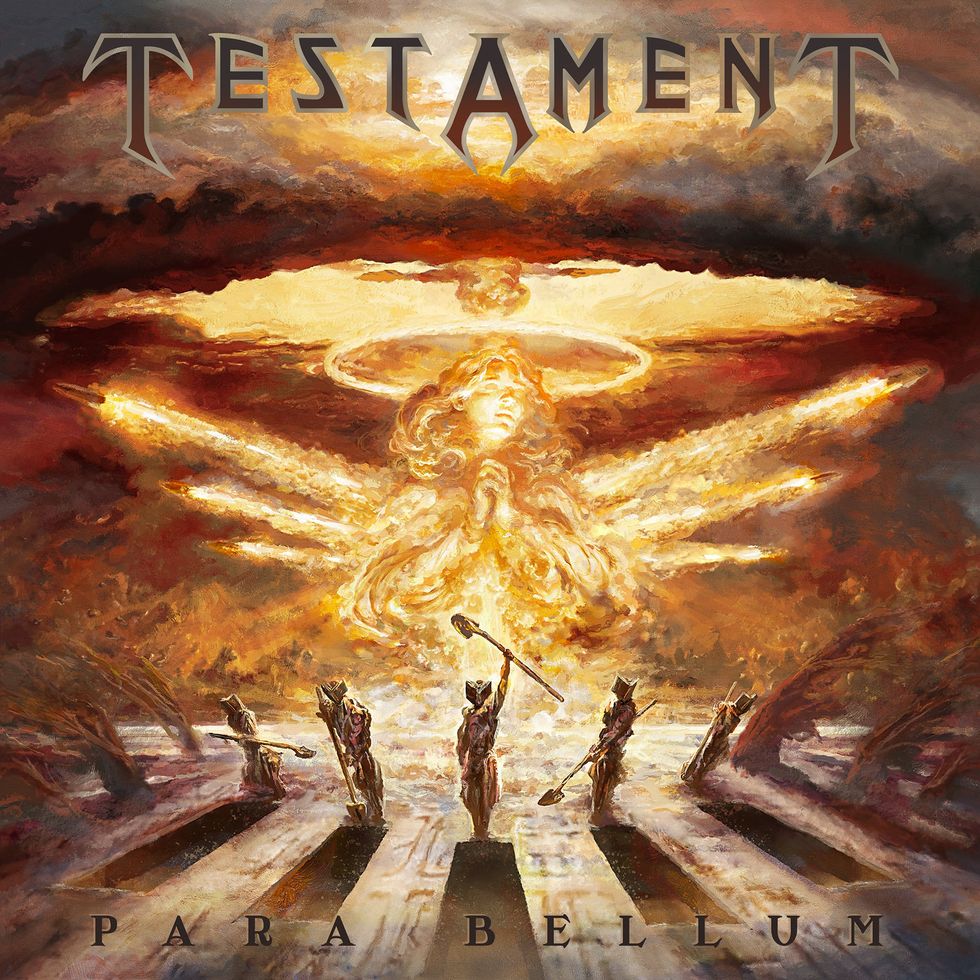
Para Bellum Tracklisting
1. For the Love of Pain
2. Infanticide A.I.
3. Shadow People
4. Meant to Be
5. High Noon
6. Witch Hunt
7. Nature of the Beast
8. Room 117
9. Havana Syndrome
10. Para Bellum
Para Bellum is now available for pre-order in the following formats:
- CD Jewel, 20 pg Booklet
- Gold Cassette (Band/King's Road Exclusive - Limited)
- 2 LP Gatefold, 16 pg Booklet
- Yellow, Black & Brown Splatter (Band/King's Road Exclusive - Limited)
- Copper (Mass Market Retail (US/EU))
- Bone & Brown Marbled (NB Europe Exclusive)
- Black and Orange Swirl + Splatter (NB Europe Exclusive)
- Orange & Black Swirl (NB U.S. Exclusive)
Para Bellum was recorded with Juan Urteaga, mixed by Jens Bogren at Fascination Street Studios, and was mastered by Tony Lindgren at Fascination Street Studios. The album is extremely polished and operating at full throttle. The band once again enlisted Eliran Kantor to create the album artwork. In an era flooded by AI-generated imagery. the hand painted creation encapsulates the album’s essence: a serene angel made of missiles, an explosion turned halo, surrounded by shovel-bearing cultists with books strapped to their faces.
From first note to last breath, Para Bellum is an album by warriors—crafted in chaos, and built to outlast the wars to come!
TESTAMENT live dates:
Latin America Tour
08.21.2025 BR Brasília @ Toinha Brasil Show
08.23.2025 BR Rio De Janeiro @ Circo Voador
08.24.2025 BR São Paulo @ Carioca Club
US Festivals
09.21.2025 US Louisville, KY @ Louder Than Life 2025
10.03.2025 US Sacramento, CA @ Aftershock 2025
European Tour
10.05.2025 DE Hannover @ Capitol
10.07.2025 UK Bristol @ Beacon
10.08.2025 UK Birmingham @ O2 Academy Birmingham
10.09.2025 IE Dublin @ Olympia Theatre
10.10.2025 UK Manchester @ Manchester Academy
10.11.2025 UK London @ O2 Forum Kentish Town
10.12.2025 BE Antwerp @ Trix
10.13.2025 DE Stuttgart @ LKA Longhorn
10.14.2025 DE Hamburg @ Große Freiheit 36
10.16.2025 CH Pratteln @ Z7 Konzertfabrik
10.17.2025 DE Wiesbaden @ Schlachthof
10.18.2025 IT Milan @ Live Club
10.19.2025 DE Saarbruecken @ Garage
10.21.2025 SI Ljubljana @ Media Center
10.22.2025 AT Vienna @ Arena
10.23.2025 PL Wroclaw @ A2
10.24.2025 DE Munich @ TonHalle
10.25.2025 DE Oberhausen @ Turbinenhalle
10.26.2025 NL Utrecht @ Tivoli Vredenburg - Ronda
TESTAMENT is:
Chuck Billy | Vocals
Eric Peterson | Guitar
Alex Skolnick | Guitar
Steve DiGiorgio | Bass
Chris Dovas | Drums
GRAMMY-winning Guitarist Tommy Emmanuel Announces New Album Living in the Light
Today, GRAMMY-winning guitarist Tommy Emmanuel announced his new album Living In The Light, out October 10. Recorded and mixed with producer Vance Powell (Jack White, Chris Stapleton, Phish), Living in the Light is a virtuosic blend of acoustic pop, jazz, classical, and roots music delivered by one of the modern era’s most accomplished and versatile guitarists. The announcement arrives alongside the official video for the propulsive debut single “Scarlett’s World,” dedicated to Emmanuel’s granddaughter.

“I tried to write a theme that sounded like it came from the 80s,” Emmanuel explains. “Scarlett is my granddaughter, so I dedicate this song to her and her journey through life. However, there is a part of me that wanted to give a nod to Scarlett Johansson as I am a big fan. She’s one of my favorite actresses.”
Emmanuel captured most of the performances on Living in the Light in one or two takes, and the sense of joy and wonder in these sonic explorations is more than just palpable; it’s intoxicating. While many of the recordings are solo instrumentals, Emmanuel lends his voice to several of the album’s tracks, as well, grounding his dazzling, percussive fretwork with a poignant dose of warmth and vulnerability. “There are elements of rockabilly, blues, even traditional African music all woven into the music,” Emmanuel explains. “I’m a world traveler, and I’ve absorbed so much music along the way. It all gets synthesized through a kind of osmosis into my psyche and my soul and then comes out in my own unique style.”
Tommy Emmanuel first began touring at the age of six in his native Australia as part of a family band. In his teenage years, he turned heads as a highly sought after session player and sideman, and by his early twenties, Emmanuel was playing on chart-topping hits and performing with some of the biggest names in Australian music, including Air Supply and Men at Work. Inspired in part by his hero, Chet Atkins (who would later become a friend, mentor, and collaborator), Emmanuel stepped out on his own as a solo artist in 1979, releasing the first in a string of critically and commercially acclaimed instrumental albums that would make him an unlikely celebrity in his home country and beyond. In the decades that followed, he would go on to headline everywhere from the Sydney Opera House to Carnegie Hall; tour with the likes of Eric Clapton and John Denver; win a GRAMMY Award for Best Instrumental Arrangement; perform for a televised audience of more than two billion at the closing ceremony of the Sydney Olympics; and collaborate with everyone from Les Paul and Mark Knopfler to Joe Walsh and Richard Thompson. NPR’s World Café declared him “one of the best acoustic guitarists in the world,” while the New York Times hailed him as a “prodigy,” and Atkins crowned him with the title of Certified Guitar Player (an honorary only ever bestowed upon four other artists).
Emmanuel continued to push himself throughout his career, relocating permanently to Nashville in the early 2000s and collaborating with a rising generation of guitarists like Jason Isbell, Molly Tuttle, and Billy Strings on his latest studio albums, Accomplice One and Accomplice Two. “Those albums were a real labor of love,” Emmanuel explains, “and I was thrilled with how they came out. But I felt a strong desire to focus on my writing again after that, and I found that the songs for Living in the Light just started pouring out of me.”
More than sixty years into his storied career, Tommy Emmanuel is still hungry for adventure. “As I get older, I find myself taking a lot more risks, and having a lot more fun in the process,” says Emmanuel, who recently celebrated his 70th birthday. “When young people come to my shows and have this awakening that it’s okay to be different, that the possibilities of music and self-expression are limitless, that’s what it’s all about for me.”
PRS Guitars Releases 40th Anniversary Custom 24 Satin Limited Edition
PRS Guitars today announced the launch of the 40th Anniversary Custom 24 Satin Limited Edition. This release celebrates four decades of PRS Guitars by bringing some new and noteworthy features to the model that started it all. Limited to 500 pieces worldwide, this special edition uniquely features a mango top, ebony fretboard, satin nitro finish, and smoked black hardware for a new twist on a classic. Each guitar includes a 40th-anniversary certificate hand-signed by Paul Reed Smith.
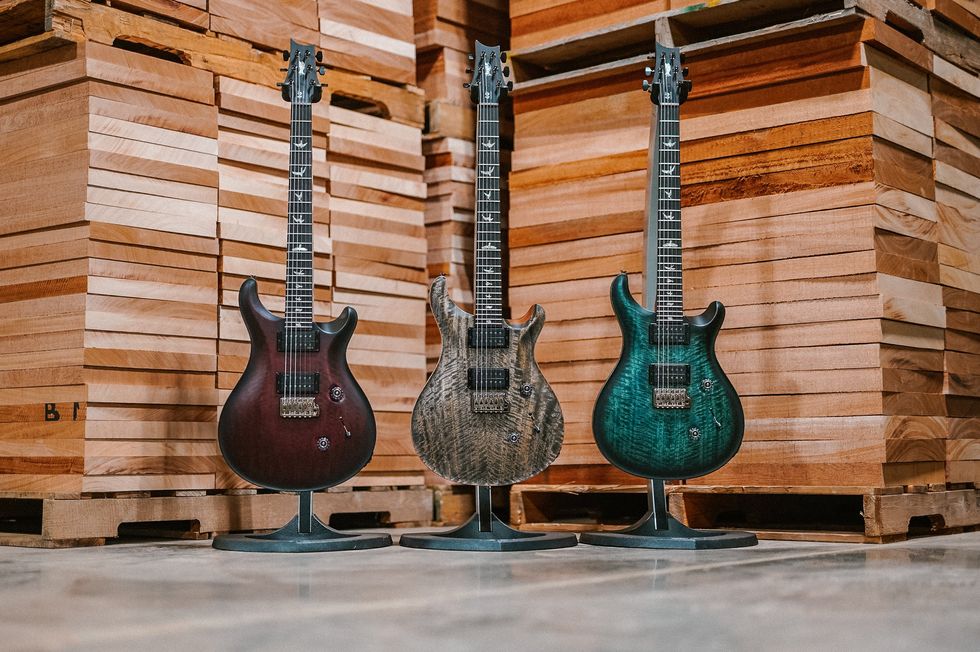
“Our wood buyers search the world over for the most extraordinary tonewoods available. These mango tops (also on the new Mark Holcomb signature model) that they acquired are visually stunning. They also have this ringing resonance to them. Featuring the new wood along with the other unique appointments give this edition of our flagship Custom 24 its own unique character, worthy of a limited, anniversary model,” said Paul Reed Smith.
While the guitar may look different, it boasts many of the Custom 24’s beloved features, including a mahogany back and neck, 25” scale length, 24 frets, 10” fretboard radius, and Pattern Thin shape. Other classic Custom 24 appointments include the PRS Gen III patented tremolo, PRS Phase III locking tuners with wing buttons.
Most notably, this limited edition exchanges the Custom 24’s classic maple top for striking figured mango. Mango wood retains much of the sound characteristics as maple while bringing an almost “quilted” look to these guitars. The satin nitro finish adds to the guitar’s unique aesthetic appeal by bringing a more natural vibe to the instrument. The ebony fretboard and headstock veneer feature PRS “Old School” birds with outlines and a PRS “Pre-Factory” eagle on the headstock, which both pay homage to early PRS guitars.
The 40th Anniversary Custom 24 Satin Limited Edition is equipped with PRS’s DMO Treble and Bass pickups. DMO pickups (DMO standing for Dynamic, Musical, Open) were spec’d by Paul Reed Smith and the PRS New Products Engineering team to have a wide-open sound with vocal character. Paired with a 5-way blade switch, these pickups give players plenty of tonal range in their dual octave package.
PRS Guitars continues its schedule of launching new products each month in 2025. Stay tuned to see new gear and 40th Anniversary limited-edition guitars throughout the year. For all of the latest news, click www.prsguitars.com/40 and follow @prsguitars on Instagram, Tik Tok, Facebook, X, and YouTube.
Last Dance with Dorian

Theory: Intermediate
Lesson Overview:
• Learn how to construct Dorian scales.
• Understand the minor-key harmony of “Last Dance with Mary Jane.”
• Develop an ability to hear the raised 6 in a minor scale. Click here to download a printable PDF of this lesson's notation.
I love modes. I love playing them. I love teaching them. But they are tricky to teach because it’s difficult to wrap your head around them without having to dive deep into theory, which isn’t an easy step for some players. As a teacher, I look for ways to make modes fun and relatable, and this always lives and dies by the quality of your examples and source materials. Over this past holiday break, I started researching the mighty 5-watt Fender Champ tube amp. What does this have to do with modes? Read on.
Tom Petty’s guitarist Mike Campbell is a well-known fan of low-wattage Fender amps. I was watching a segment on the history of the Champ and when the main riff to “Last Dance with Mary Jane” came up, it piqued my interest. It was a song I knew well, hadn’t really heard in a long time, and never had a reason to study—until now.
There was something about the song that was unique and I wanted to dig into. And because I needed inspiration for a new lesson, the timing was perfect. The first thing I like to do when figuring out how a tune works is to lay out the main chords as an inventory. For this tune, the chords are pretty simple:
Am–G–D–Am
Yet again, Tom Petty takes a simple harmony and crafts an enduring rock anthem around it. We all joke about three-chord rock, but this is not only three-chord rock, it’s modal as well. So, why is this a Dorian chord progression? Just looking at the chords might be enough if you’d studied harmony a ton, but if you haven’t, the next step we should take is to spell out the chords into their individual notes:
Am = A C E
G = G B D
D = D F# A
Now that we’ve deconstructed the chords, the next task is to decide which note you think is home, or in theory-speak, the I. In this case, it’s pretty clear that A is home. We keep coming back to it, and it really does feel and sound right. With that done, we can take the chord tones and alphabetize them, starting with A. This yields a string of seven notes: A–B–C–D–E–F#–G.
Okay, we’ve taken inventory of all the notes contained in those three chords, starting from our root (A). The next step is to ponder the harmonic consequences of this discovery. What makes this a Dorian progression is the D major chord with an Am tonic. This D triad brings us an F#, which is not the normal F you’d see in an A Aeolian, aka A natural minor, scale (A–B–C–D–E–F–G). With Dorian, you end up with a scale that sounds minor, but with a raised 6, compared to natural minor. This yields an intriguing sound that’s not quite as dark as the minor scale you’re accustomed to. Many people describe and teach Dorian as a minor scale with a raised 6, and that’s exactly what we have here.
To get familiar with this sound, grab “Last Dance with Mary Jane” on your favorite music service and play along in A Dorian. Ex. 1 shows a handy scale diagram based on the 5th fret root of A on the 6th and 1st strings.

Now that we’ve connected the chords to the Dorian mode and we have a scale fingering, let’s hear some riffs in context.
For Ex. 2, I’m keying off the fact that this Dorian scale position is in the same spot as the familiar minor pentatonic scale, so we’re getting to use both the mode and the pentatonic in the same phrase. I’m featuring the F# (or the 6) as the signature note that makes Dorian unique, and also because it’s the 3 of the D major chord. You can play that F# whenever you want in this progression, but it’s extra awesome over the D chord.
Click here for Ex. 2
With its bluesy beginning, Ex. 3 is another line that relies on the pentatonic scale lurking inside of the Dorian scale. Again, when the D major chord occurs in the second measure, I’m calling attention to it with the F#. It’s a simple way to connect with the Dorian scale and still keep that rock/blues feel we all love.
Click here for Ex. 3
For our final example (Ex. 4), I stayed away from the pentatonic sound and tried to create a simpler melody with just the Dorian scale. It starts in the middle of the guitar’s range and follows a see-saw pattern of “go up a few, go down a few.” At the start of each chord change—every two beats—I align to the chord in the progression: A for the Am chord, G for the G chord, and F# for the D chord. This is a little bit of voice-leading that reminds me of “While My Guitar Gently Weeps.” It not only helps you anchor the chord progression, but it connects with the mode at the same time. We’re only using a portion of Ex. 1’s two-octave scale pattern—sometimes simple is best.
Click here for Ex. 4
But wait there’s more! While the opening chords clearly spell out an A Dorian progression, the chorus shifts to yet another modal key. This song keeps on giving us things to learn and practice—how cool. When the chorus starts, we hear the following chords:
Em–A–Em–A–G
As before, let’s pull the chords apart to see what’s inside:
Em = E G B
A = A C# E
G = G B D
And just like last time, we need to determine the root. In this case, it’s clearly E minor, so we’ll call this an E something mode. Starting with E, let’s ascend through the pitches to see what we get:
E–G–A–B–C#–D
This gives us six notes. While we’re missing the second note after E (which, in a seven-note scale, would be some type of F), we can still conclude it’s another Dorian scale, this time in the key of E. Relative to E, C# is a raised 6 and this matches our general idea of Dorian construction: minor scales with a raised 6. It’s really cool that this song allows you to practice in two keys, A Dorian for the verse and E Dorian (E–F#–G–A–B–C#–D) for the chorus.
Ex. 5 is a scale diagram for E Dorian. Note that it’s the same pattern as our previous A Dorian scale, just shifted up to the 12 fret to place the E root on the 6th and 1st strings.

The chorus is my favorite part of the song because it’s a moment where everything comes together—the chords and Petty’s vocal melody combine for a beautifully haunting Dorian sound. Pay attention to the “ry” in the melody of “Mary” to hear that C# over an Em chord—that’s the distinctive Dorian color at work. It’s one of the reasons I’ll keep this song in my arsenal of material for teaching Dorian to students, along with Pink Floyd’s epic “Breathe” from Dark Side of the Moon. (Go work out the Dorian key for that one.) For now, use the above examples for inspiration and find your own riffs and ideas for “Mary Jane.” Let your creativity and ears be your guide.
I hope you enjoyed exploring how to reverse-engineer a simple song. Over time, this process will become faster and you’ll be able to hear the modes more easily. The next time a tune really tickles your ear, take it apart as we’ve done here. Who knows? It may spawn a soloing concept or a song idea you wouldn’t have otherwise considered.
Mastodon Founding Guitarist Brent Hinds Dies at 51

Brent Hinds, the cofounding guitarist of veteran Atlanta metal band Mastodon, died last night, August 20, after a motorcycle crash. According to Atlanta News First, Hinds was riding a Harley-Davidson and collided with an SUV, which failed to yield while turning through an intersection. His death was confirmed by the Fulton County medical examiner’s office.
Formed in 2000, Mastodon’s original lineup of Hinds, bassist/vocalist Troy Sanders, guitarist Bill Kelliher, and drummer/vocalist Brann Dailor remained unchanged until this year. Hinds’ playing, often powered by Gibson guitars and Orange amplifiers, earned him recognition as one of the most potent, powerful guitarists in modern metal. Hinds also played with the bands Fiend Without a Face, Giraffe Tongue Orchestra, Legend of the Seagullmen, and West End Motel.
Hinds left Mastodon in March this year on what appeared to be amicable terms, but his exit seems to have been more acrimonious than initially reported. In the past few weeks, a series of social media posts from the guitarist criticized his former bandmates and suggested that he was kicked out of the band.This morning, fans and peers began leaving messages of love and remembrance on Hinds’ latest Instagram post, uploaded yesterday.
Earlier today, August 21, Mastodon shared a tribute to Hinds on their official social media:
We are in a state of unfathomable sadness and grief… last night Brent Hinds passed away as a result of a tragic accident. We are heartbroken, shocked, and still trying to process the loss of this creative force with whom we’ve shared so many triumphs, milestones, and the creation of music that has touched the hearts of so many. Our hearts are with Brent’s family, friends, and fans. At this time, we please ask that you respect everyone’s privacy during this difficult time.
The Best of All Eras: The One-of-a-Kind Partscaster Jazzmaster
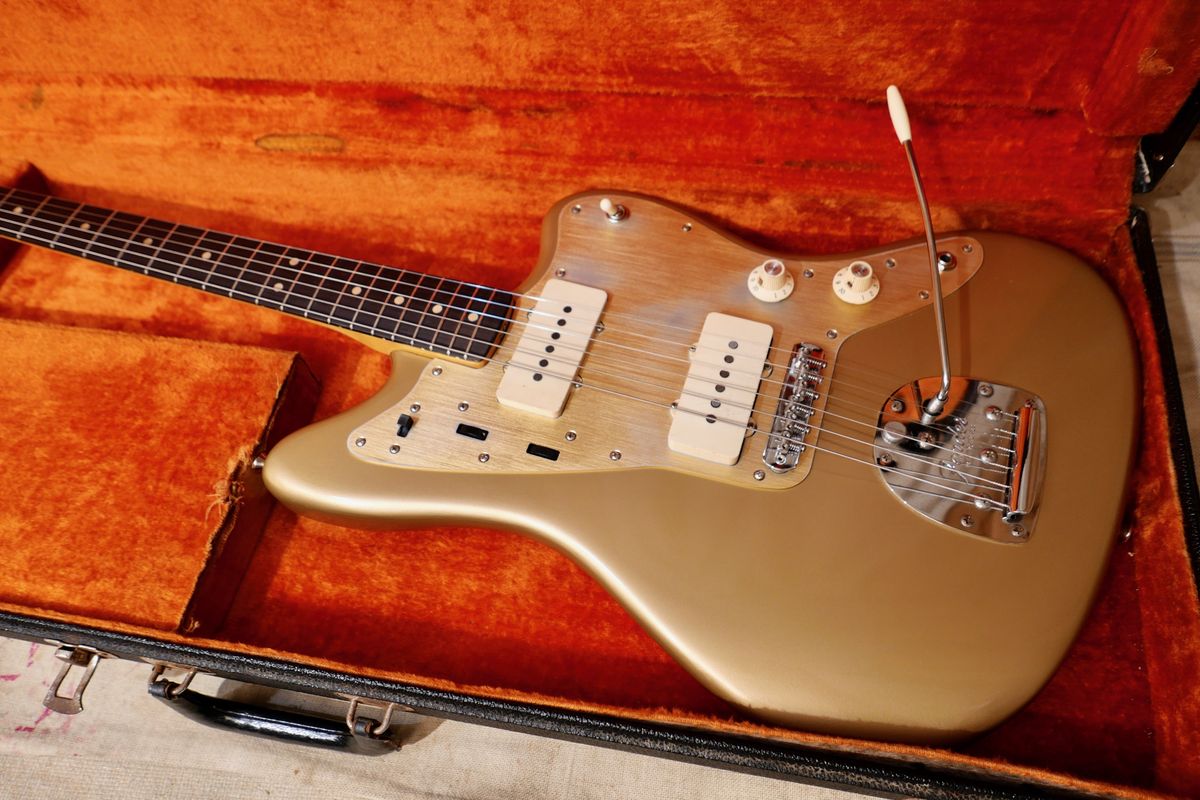
Vintage Fender cool at an even cooler price.
Back when Leo Fender was first designing his namesake instruments, he made a key decision that few of his contemporaries considered: bolt-on necks.
Gibson, Epiphone, Gretsch, and other companies of the era were often dedicated to the traditional construction method of set necks, where a joint is crafted at the butt end of the neck from the very same piece of wood, fitted into the body, and glued in place. Leo took what he saw as a more eminently practical approach: Just screw the thing on.
In an interview with guitar writer and historian Tom Wheeler many years later, he explained his decision: “I did it because when you build a guitar and neck that are joined in one piece or bonded, then, when you have a flaw in the neck, you have to decide between putting up with it or junking the whole damn thing—body, neck, and all. So I decided that it’d be best for the customer if I built the body and neck separate. It’s functional. That’s why we did it.”
To anyone that has read about Leo’s design ethos before, you’ll recognize that this idea of practicality was central to nearly everything he did. He wanted Fender instruments to be made, first and foremost, for working musicians, like the gigging country and western pickers he catered to in 1950s Southern California (and who he often used as beta testers throughout his guitars’ development).
Did your neck take a beating at some rowdy honky-tonk? Bolt on another. Did a pickup crap out? Pop off the pickguard and swap in a replacement. Oh, the Telecaster’s body is digging into your ribs? Let’s rout some contours into these new models so it feels more comfortable. Or so the thinking went.
Compared to the delicately featured archtops coming out of other shops in the mid-20th century, Fenders were built to perform. One great consequence of this decision is that it spurred the creation of “partscasters.”
This compound word can be defined as the amalgamation of various parts (parts-) in an otherwise Fender or Fender-style guitar (-caster). And it’s certainly not always the case that parts are swapped only when issues arise, but also when an owner makes the intentional decision to try a new body, neck, or electronics to go after a particular feel or sound.
“This guitar is a marriage of pre-CBS feel, CBS-era savings, and mostly modern electronics and hardware that are sure to last.”
The benefits of this approach are many, especially if you’re buying a partscaster someone else has already built. By and large, on the used or vintage market, a partscaster will almost always be less expensive than a factory-original model of the same era—they are often even less expensive than if you bought each part individually—and it could very well be a better playing guitar, to boot.
Case in point: The vintage partscaster Jazzmaster featured in this edition of Vintage Vault. For sale by the fantastic Reverb seller Southside Guitars, this partscaster Jazzmaster is a true player’s instrument. It has a 1964 neck—the last year in which the coveted Brazilian rosewood fingerboard was used on production models—attached to a 1972 Jazzmaster body, which can be a tad heavier than ’60s models but is the same shape and dimensions.
Overall, this guitar is a marriage of pre-CBS feel, CBS-era savings, and mostly modern electronics and hardware that are sure to last. While the tremolo and neck plate are original, nearly everything else has been replaced, with Seymour Duncan pickups taking the spot of the ’70s Fenders and both the body and the pickguard getting refinished in gold sometime in the past.
The best part of all these changes? The asking price of $4,980. While still a good chunk of change, that is significantly less expensive than any all-original ’64 Jazzmaster you could find, which, these days, can easily approach or pass the $10,000 mark. (Back when they were released, a ’64 Jazzmaster would have retailed for $349–$429, and ’72s would have been $419–$439. Adjusted for inflation, either model would cost at least $3,500 in today’s dollars.)
Vintage guitar prices, on the whole, have hit some of their highest peaks in recent years. At Reverb, from 2015 to 2023, we saw increasing prices not just for the fashionable pre-CBS Strats and Teles and equivalent pre-Norlin Gibson Les Pauls, but basically anything under the vintage umbrella. Some collectors will pay hundreds of dollars for original screws if that’s what they need to complete an otherwise all-original specimen. If parted out (again) from this Vintage Vault Jazzmaster, the original neckplate alone could go for a few hundred dollars, while the ’64 neck and ’72 body could fetch many thousands of dollars apiece.
So, if you’re a buyer who is interested in owning and playing a vintage guitar, you’d do well to remember the working-musician ethos with which Leo started the brand and consider a vintage partscaster. A different neck or different pickups is not the mark of a lesser instrument, but the mark of a well-played gem.
Sources: American Guitars: An Illustrated History by Tom Wheeler; Gruhn’s Guide to Vintage Guitars by George Gruhn and Walter Carter, Reverb Price Guide sales data
Nashville’s Modern Honky-Tonk (Guitar) Hero
John Bohlinger spends some quality time with the Telecaster powerhouse keeping Don Kelley’s legacy burning bright at Robert’s Western World. McQueary shares some subtle tone tips, recounts memories of performing alongside his heroes (and Kelley alumni), explains his constant pursuit of nuance in tone—often finding more magic in playing softly than turning up, and details the journey that took him from bystander to Nashville Broadway showman.
Digitech HammerOn Review
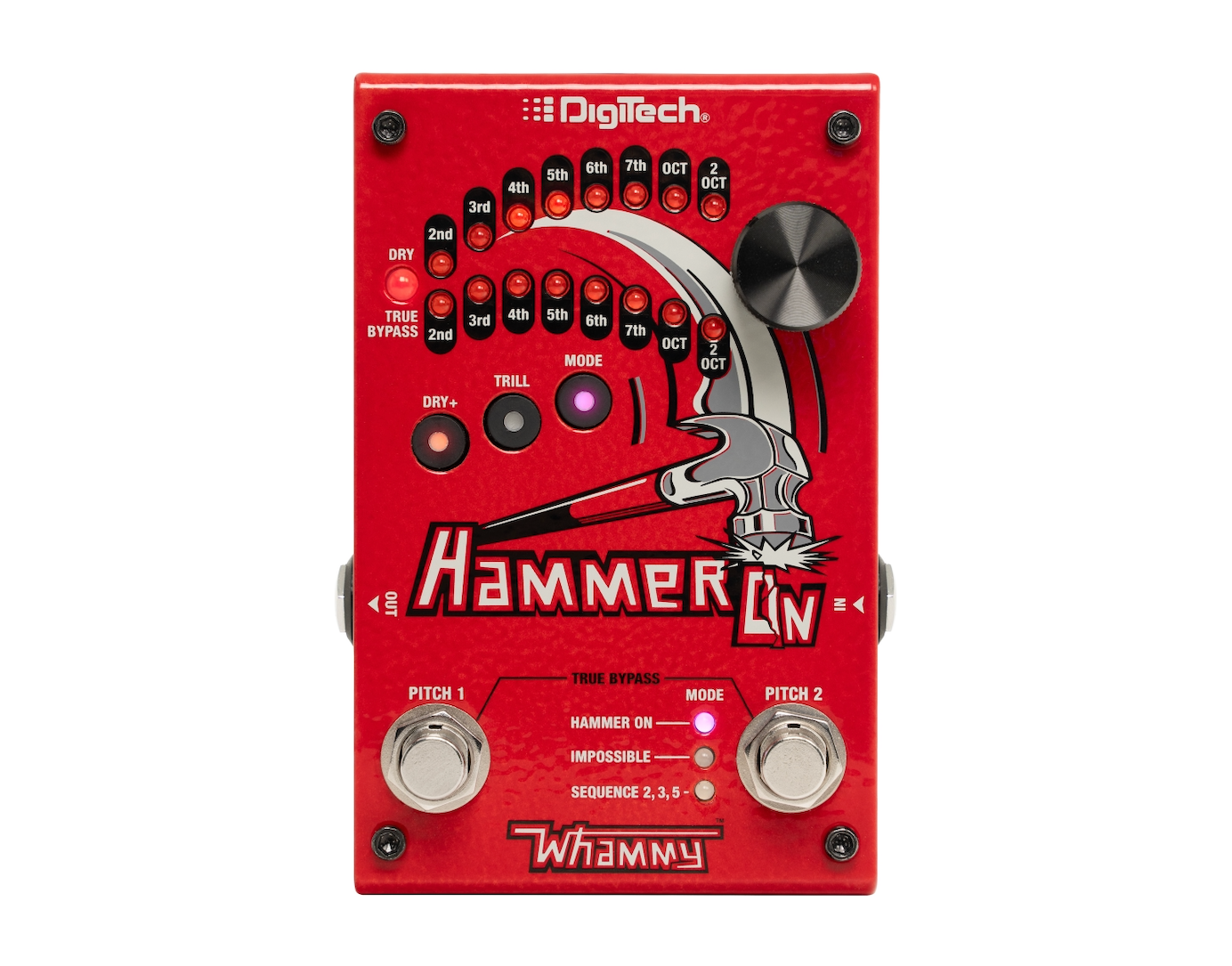
Digitech says its latest creation, the HammerOn pitch-shifting pedal, is “seven pedals in one.” That left me pondering what constitutes a “pedal” in this scheme. I think the more accurate and descriptive term may be “modes.” But those seven pitch-shifting modes deliver in really fun ways.
Operationally speaking, the HammerOn is fairly straightforward. When you step on either of the sturdy-feeling footswitches, whatever note(s) you play morph instantly to a different pitch of your choice. But this simple premise still makes the HammerOn a compelling addition to the Wham’ Fam’.
Mode Mentality
Hammer-on mode, which I essentially described above, is the most straightforward application of the pedal’s potential. But there is also an Impossible mode, which alternates between two different pitches, making once “impossible” fretboard maneuvers much more possible. Sequence mode strings together multiple pitch changes in different ways. And with any of these modes, you can add in your unaffected signal using the dry+ button or force the HammerOn to alternate pitches on its own with the trill button. According to the manual, these three modes, combined with the dry+ and trill buttons, account for the seven different “pedals” mashed together here.
“I even came up with a pretty strange-sounding chorus so odd that I giggled out loud.”
HammerOn’s modes, if not exactly independent pedals, are nevertheless capable of cool tricks. Certain pitch shift moves can work like a harmonizer, others like an alien 12-string emulator, and some like a capo that extends your guitar’s scale. In hammer-on mode, you hear plenty of the digital-icious glitchiness from the Whammy algorithm. You can also build sequences that evoke synthesizers, and it’s great, perverse fun to set the HammerOn to an odd interval like a flat 5th and smear otherwise pedestrian licks with a footswitch. I even came up with a pretty strange-sounding chorus so odd that I giggled out loud.
The HammerOn has plenty of practical uses, but its real magic lies in how it nudges you into unconventional musical territory, encouraging you to loosen your grip on habits and familiar fretboard patterns—much like the original Whammy. Ultimately, it’s a great tool for shaking creativity loose.
Ty Myers Rig Rundown
The TikTok star goes legit on his latest tour with some plum Strats, a Two-Rock, and a masterbuilt pedalboard.
When Ty Myers got injured a few years back and couldn’t play sports, he took to posting videos of himself on TikTok. Before long, his song “Tie That Binds” went viral on the platform, blasting him to overnight-star status. Now, with his debut album, The Select, under his belt, the 18-year-old is taking his songs on the road to packed-out rooms.
PG’s John Bohlinger linked with country’s newest wunderkind at the Egyptian Room in Indianapolis to see how he brings his old-time-meets-new-world country to life onstage.
Brought to you by D’Addario.
San Antonio Strat
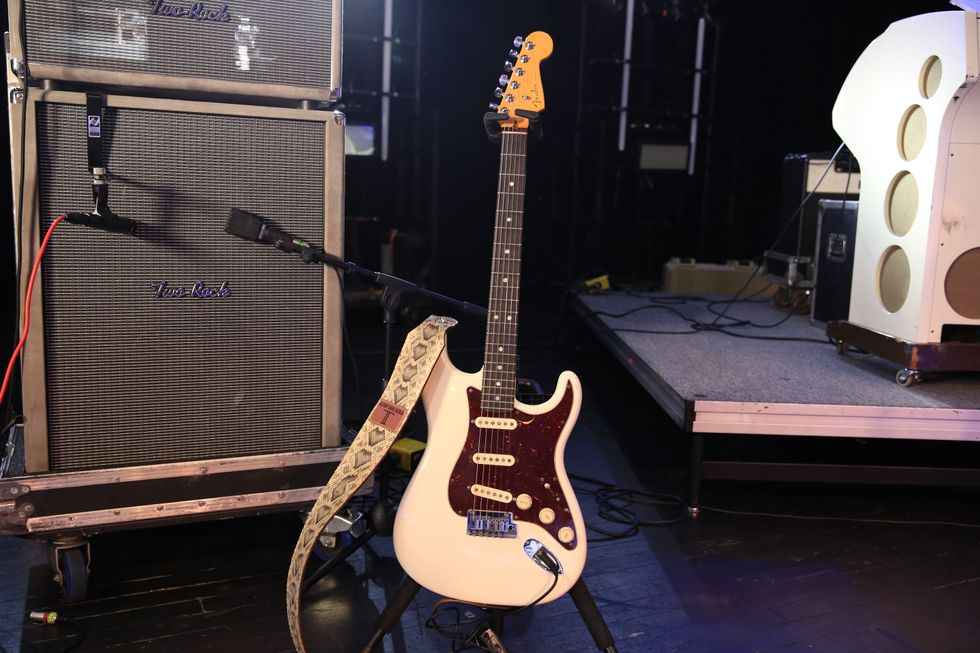
This Fender Stratocaster, the first nice guitar Myers bought himself, was purchased from a guy in a Home Depot parking lot in San Antonio, Texas. Myers swapped in Fender Custom Shop Fat ’50s pickups, and he strings it with Stringjoy .010s.
Eye-Catching Custom
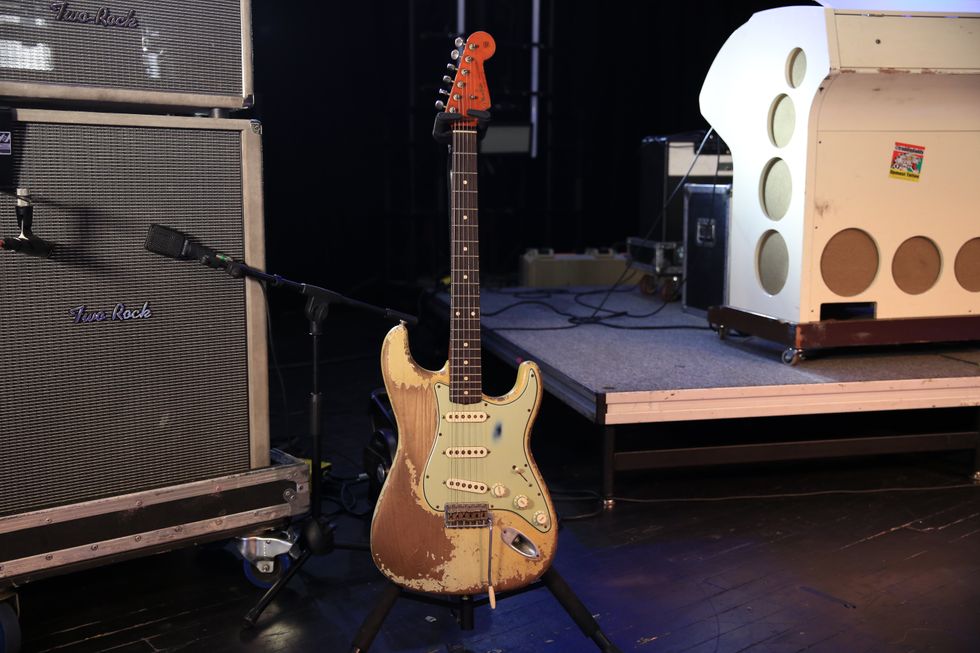
If Myers played slide, it’d be with this Custom Shop Master Built Strat, built by Dale Wilson. He went to Carter’s Vintage in Nashville with another instrument in mind, but this one caught his eye, and he had to have it. He kept the pickups it came with, and pretty soon he intends to have the action lowered.
Barry’s Bond
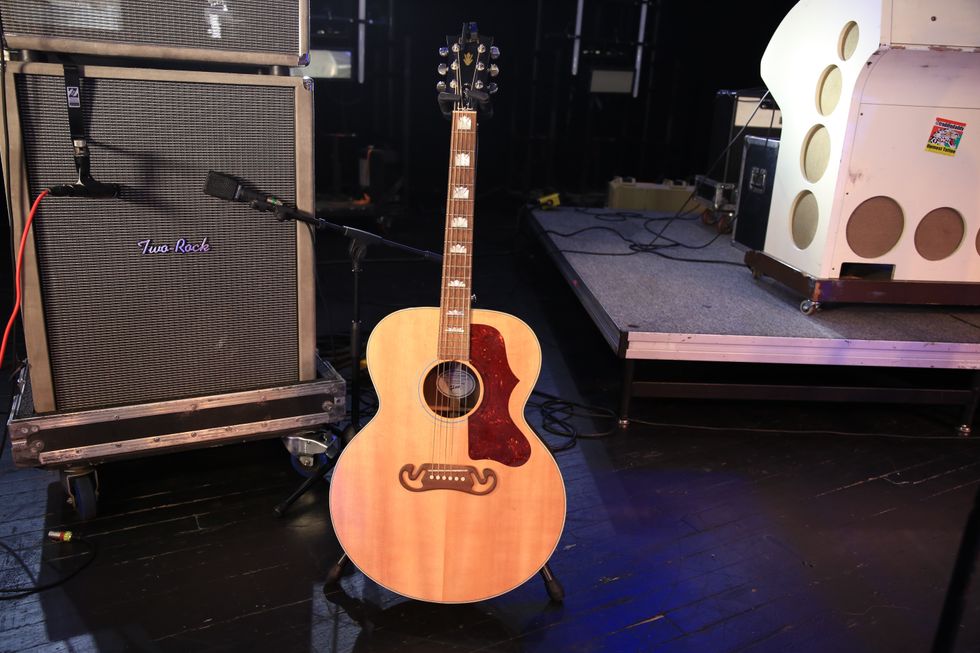
Myers got his first Gibson SJ-200 around the age of 10, and this one, a gift from label executive Barry Weiss, is his current go-to. It’s got an LR Baggs pickup system and goes direct to front-of-house.
Package Deal
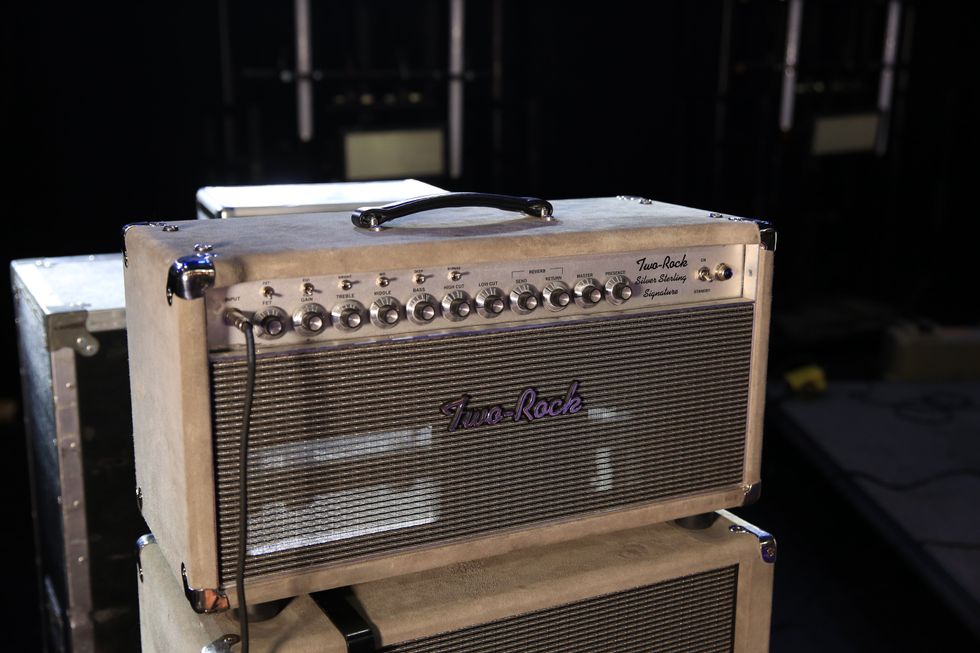
Myers’ biggest hero is John Mayer, so it tracks that he went after this Two-Rock Silver Sterling Signature. He saw this one at Carter the same day he bought his Custom Shop Strat, and didn’t even plug it in—he just bought it along with the Master Built.
Ty Myers’ Pedalboard
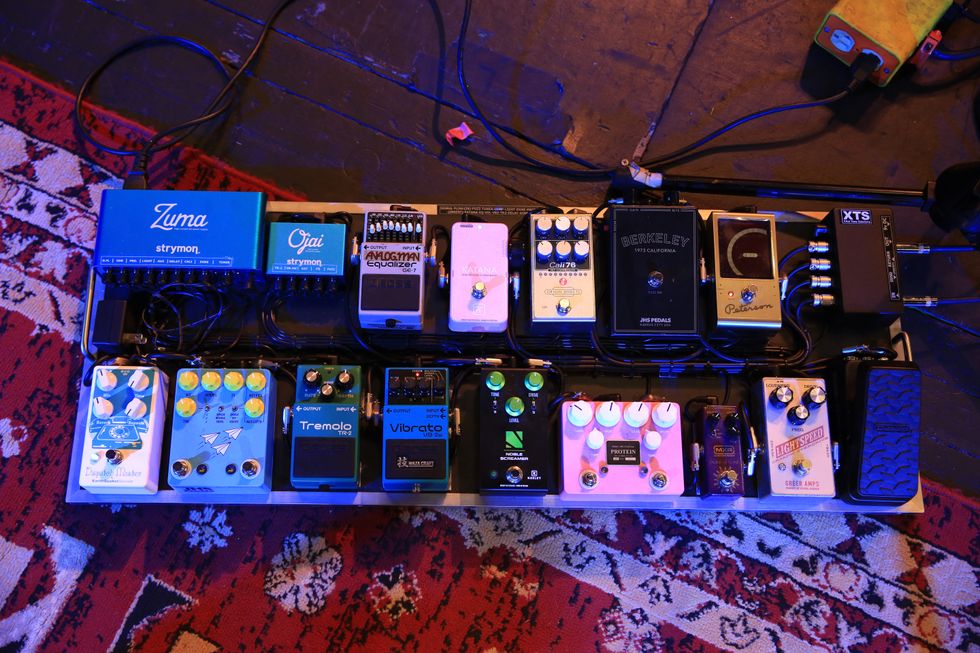
Myers’ stomp station was built by the pedal professors at XAct Tone Solutions in Nashville. After the Dunlop Volume (X) Mini and the Peterson StroboStomp LE, Myers’ signal hits an Origin Effects Cali76, JHS Pedals Berkeley, Keeley Katana, Analog Man/Boss GE-7, Greer Lightspeed, MXR Duke of Tone, Browne Amplification Protein, Keeley Noble Screamer, Boss VB-2w, Boss TR-2, JHS Flight Delay, and EarthQuaker Devices Dispatch Master. A Strymon Zuma and Strymon Ojai keep the lights on.

Fender Custom Shop Masterbuilt Stratocaster
EarthQuaker Devices Dispatch Master
Surfin’ Safari, Japan-Style: Meet the Intermark Cipher Surfer
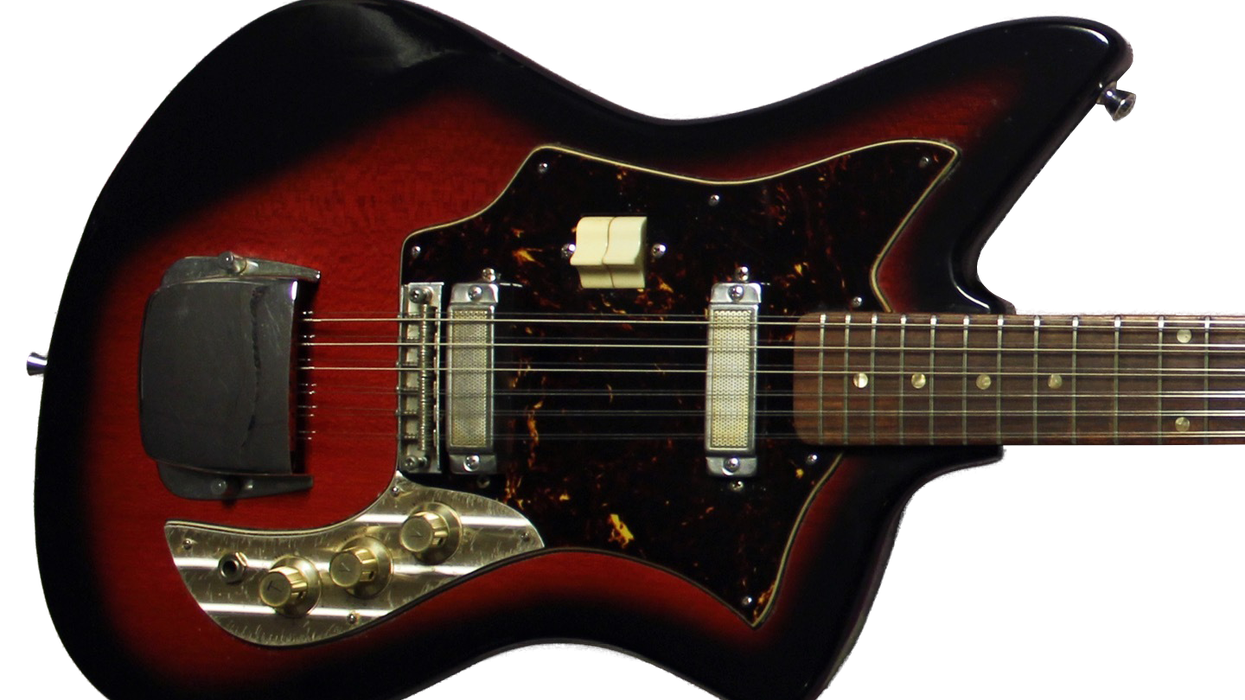
It’s about that time of the year when the family goes “down the shore,” as they say in my part of the world, for our annual vacation. We’ve been all up and down the East Coast shoreline, from Maine to South Carolina, but we usually settle in Delaware and all the quaint little escapes to be found.
Personally, I don’t really do much at the beach except meditate and people watch. Sometimes I don’t even bring a chair. Instead I just scoop out a “recliner” in the sand and ponder all sorts of musings. I’m fascinated by ocean living, and have wondered what it would be like to live at a house where you have to tie down your garbage cans so they don’t float away in a flood. At one point in our vacation we experienced a horrific thunderstorm and I had my son convinced that our car might float out into the ocean since we were right near the water. Good times!
So a few weeks ago, there I was on a Delaware beach thinking about life and how if I could choose to live anywhere or be anything, like a start-over, I think I would’ve enjoyed living along the shores of California and being a surfer. An idealized version, I suppose, but it seems cool in my mind. Of course I’d have to be 30 years younger, 50 pounds lighter, and operate with some semblance of balance, but hey, endless summers, baby!
In 1966 there was an awesome surfer documentary called The Endless Summer that chronicled a global search for the perfect wave. Director Bruce Brown’s film was filled with a cool soundtrack and the whole endeavor created a phenomenon of sorts which featured travel, music, culture, and a lifestyle that I just adore.
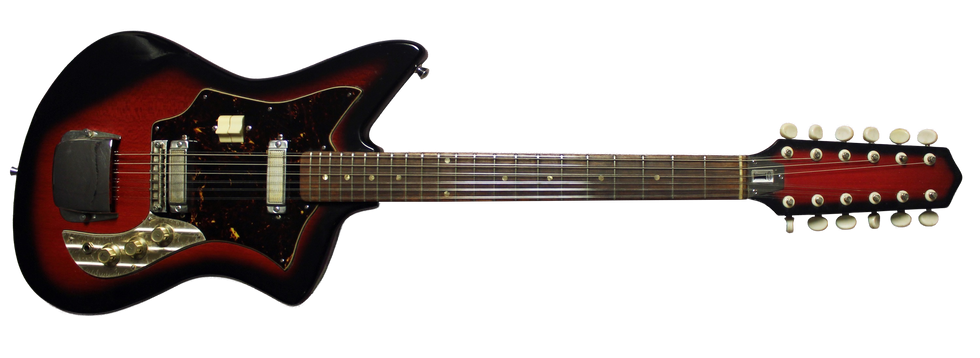
“Why would you associate a 12-string with surf music? The ’60s were different times.”
There were already plenty of surf bands at that time, such as the Ventures and Dick Dale, who embraced mostly instrumental music. That really appealed to fans around the world because the language barrier didn’t exist. And of course, there were a plethora of guitar ads that combined surfing with instruments. But sitting there in Delaware, I got to thinking about guitars that had “surf” in their name. There were newer models like the Charvel Surfcaster, but I was having a hard time coming up with vintage guitars. And then, just like a lightning strike during that coastal storm, it hit me … the Intermark Cipher Surfer from 1965!
For about two years, the Shinko Gakki Company in Japan produced electric guitars in the Tatsuno Lake region (which is a great spot to visit). Shinko guitars were mostly sold in Japan but most of the electrics sold in the States were imported by the Intermark Corporation in New York. Intermark imported all sorts of stuff from Japan and often the Cipher name was attached to products. Hence, the long-ish Intermark Cipher guitars. There were all sorts of configurations, such as basses and 12-strings along with a number of pickup configurations and, sometimes, super-cool colors such as yellow, green bursts, and wonderful glitter finishes. Now the rub here is this: They labeled the 12-string the Surfer. Why would you associate a 12-string with surf music? The ’60s were different times.
The Surfer did turn out to be an excellent guitar anyway, mainly because Shinko really tried to make solid instruments when it came to build quality, and especially the great-sounding pickups. Modeled after Italian EKO units, Shinko decided to make these pickups a little stronger with the 12-string. The body shape is reminiscent of a curling wave, I suppose, with its exaggerated offset points. But the first thing I noticed when playing the guitar was that the neck was really robust. On some 12-strings I often find my fingers cramped on the fretboard, but the Intermark Surfer had plenty of room because the fretboard was wide and the neck was deep. I never worried about this guitar going out of tune. Two volumes and one tone knob were paired with simple on/off switches for each pickup, and an overall fine bridge was enough to make the Byrds play surf music!
Can One Box Replace Your Whole PA?| Yorkville EXM Pro10
Yorkville EXM Pro10 Battery-powered 10-inch Portable PA Speaker
HighPerformance 10" Battery Powered PA
EXM Pro 10 Features:
- 10" woofer + tweeter, 134 dB max SPL
- 3-channel mixer w/ reverb, delay & compression
- Battery or AC powered (up to 12 hrs)
- Multiple EQ modes: Monitor, Live, Club
- Expandable w/ subs, stereo linking, external mixers
Marshall JVM, JCM800, JCM900, and DSL Pedal Reviews
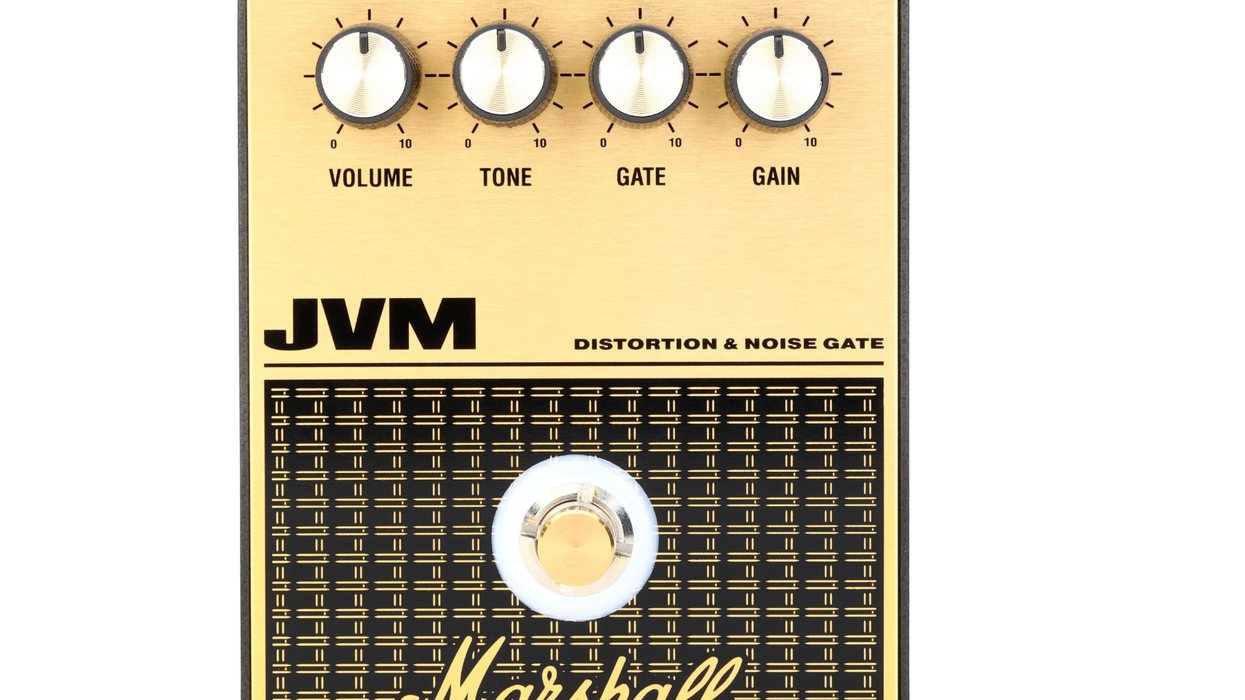
Marshall enters the amp-in-a-box ring with a series of true heavyweights that punch hard but can also dial back.
If you’d like to own a stable of classic Marshall heads but your budget won’t say “yes,” the legendary UK company may have a solution in the form of their recent line of amp-in-a-box overdrive pedals. They’ve put five of their greatest hits—the Super Lead (reviewed separately in our July issue), the JCM900, JCM800, the DSL, and the JVM—in 5" x 4" x 1 1/2" stomps, with a black-and-gold panel-and-grille-cloth motif. Sonically, they range from “nailed-it” to stunning. And at $159, all four total less than the tab for a 100-watt DSL head and just a bit more than the 20-watt version, to say nothing of the $2,899 it takes to grab a new JCM800. With this snarling, all-analog, true-bypass quintet, all you need is a solid pedal-platform amp and a humbucking or single-coil 6-string, and you’re in business.
Admittedly, my test amps were very solid: a Carr Vincent and the company’s Telstar. But I also have extensive experience with 800s and Super Leads, and I know a good time when I hear it. Whether spanking a PRS SE Silver Sky, a ’68 Les Paul Standard, a custom Zuzu with coil-splitting, or a been-through-Hell Tele with humbuckers, the results are gritty and sparkling, with rich midrange tones and plenty of articulate brightness in these pedals’ simple controls. And while these creations take a standard barrel-pin connector, they also run on 9-volt batteries, which makes them an easy drop-and-go asset for backline gigs.
JVM Distortion & Noise Gate
Generally, I’m a low-to-medium gain player…until I plug into a Marshall. At club and practice room volumes, I like to crank the gain all the way, use the master to set my level, and then adjust the tones with a prejudice toward floored mids, or close to that, and highs somewhere around 2 or 3 o’clock, depending on the amp and guitar combination. This modus operandi paid off immediately with the JVM. In fact, it was a rewarding strategy for each of these pedals.
What’s appealing to guitarists like Joe Satriani about JVM heads is their blend of controllability, touch response, grit, warm midrange, and singing sustain. The JVM has its grounding in the kind of classic Marshall tones initially made by the Super Lead, but with extra sizzle and snap via a lot of smooth, highly controllable, well-balanced gain.
Strapping in for a flight with all these pedals is the very definition of plug and play. The JVM has just four dials: volume, tone, gate, and gain. The gate is perfectly effective. If you’re cranking the gain, just dial up the gate until the hiss disappears. And unlike many gates, it leaves your core tone shining. The tone control has range enough that the amp’s 3-band EQ is not missed (at least by me). And while the pedal can get very loud, rolling back the gain to noon-ish and peeling off the gate creates nice low-gain-amp tones not typically associated with JVM heads. That makes this pedal a joy to play and, whether you’re a high-gain or low-gain partisan, gives it the potential to lead you to tonal places outside your usual wheelhouse.
Ratings
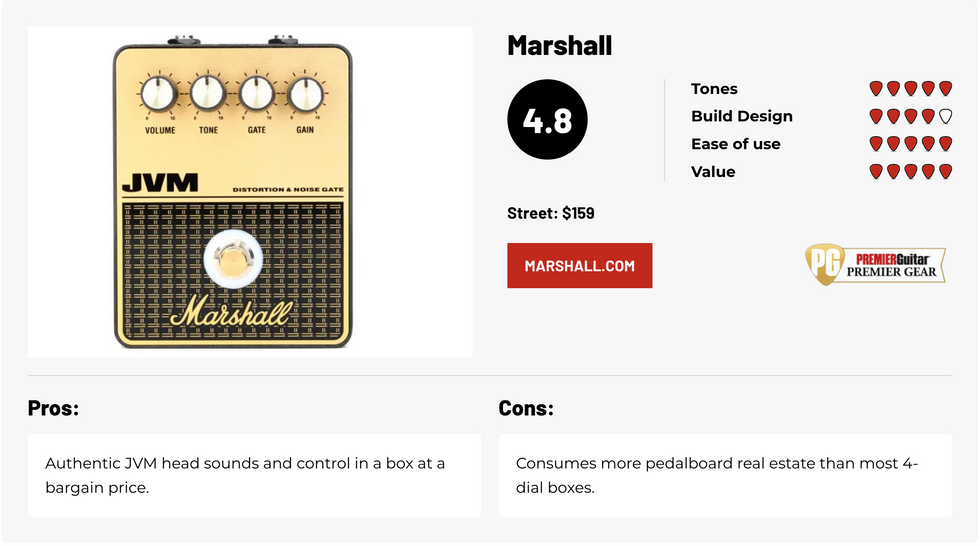
JCM800 Lead Series
This is a pedal version of Marshall’s flagship ’80s head that helped produce many of that decade’s defining guitar voices—most notably, perhaps, Slash’s. Like the other boxes in Marshall’s new silicon-based overdrive stomp series, it rekindles those voices admirably. Its overall sound is a little looser than the JVM pedal, with a somewhat darker character, which might make it an appealing Marshall gateway for players who typically go low-gain but yearn for a taste of the wild side.
The JCM800 has plenty of controllability and volume in its 4-dial setup. Here, the knobs are gain, volume, and tone, naturally, with the addition of sensitivity. Sensitivity isn’t the same as presence, which boosts upper-midrange and treble frequencies. Instead, the sensitivity dial controls the amount of signal that goes into the preamp stage of an amp. The higher it’s turned, the more tube saturation and gain. (In older Marshalls, this aspect of tone coloration was often accessed by jumping the high and low inputs of amps like the Super Lead with a short cable.)
Keep both this dial, which emulates that process, and the gain low, and the JCM800 pedal takes a softer route, with less growl and a looser response to your fingertips and picking. Turn it up and the sound becomes nasty and more harmonically rich and reactive. In my opinion (and I toured with a JCM800 for years), these amps and this pedal have a buzzing quality in their sonic character until the gain is pushed to 2 or 3 o’clock, the tone past noon, and, in the pedal’s case, the sensitivity moves to about 2 o’clock. At these settings, the volume needs to rise to about 10 o’clock or better for the tone to open up, and that’s really pushing it in smaller rooms. But there are some great voices in the blend, and setting sensitivity to 10 o’clock, cranking the gain all the way, moving the tone to 1 or 2 o’clock, and the volume to 3 or so delivers lovely hard-rock crunch. Of course, that’s all subjective and influenced by what amp you’re pushing these pedals through, so the best test, as always, is firing one up for yourself.
Ratings
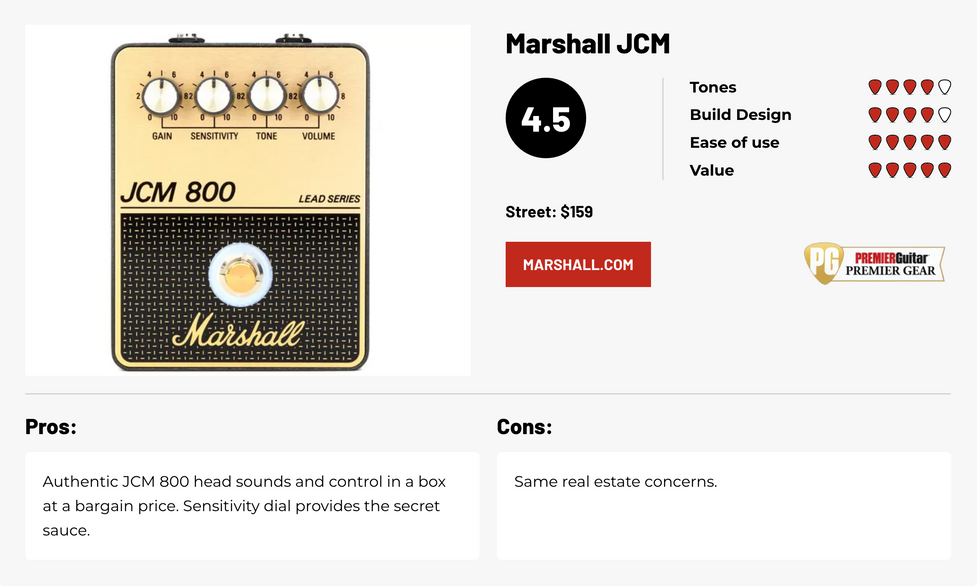
JCM900 Hi Gain Distortion
To my ears (and fingers), JCM900 heads have a tighter sound and are more responsive to your hands than 800s. I got the same impression playing this pedal too, which makes the JCM900 more genre-flexible, in my book. The secret sauce in this stompbox is administered via the contour control, which joins the gain, tone, and volume dials. Turn it down and the mids become scooped; turn it up and they are pushed to the fore.
This box is capable of tight ’80s and ’90s rhythm sounds, with the gain at 3, contour at 6, tone straight up, and the volume wherever makes you happy. Overall the tones are sparkling and snappy. Push the contour higher and mid-heavy lead sounds soar out, especially with the tone past 2 or 6 o’clock. This territory is blues-rock paradise. But my favorite setting was with the gain full-on (of course), the contour and tone around 1 o’clock, and the volume at 11 o’clock, crafting a blend of tough, biting, and sweet. I didn’t find the JCM 900 as versatile as the JVM or DSL pedals, but it’s nonetheless a charmer and, depending on your palate, may be perfect for your tastes.
Ratings
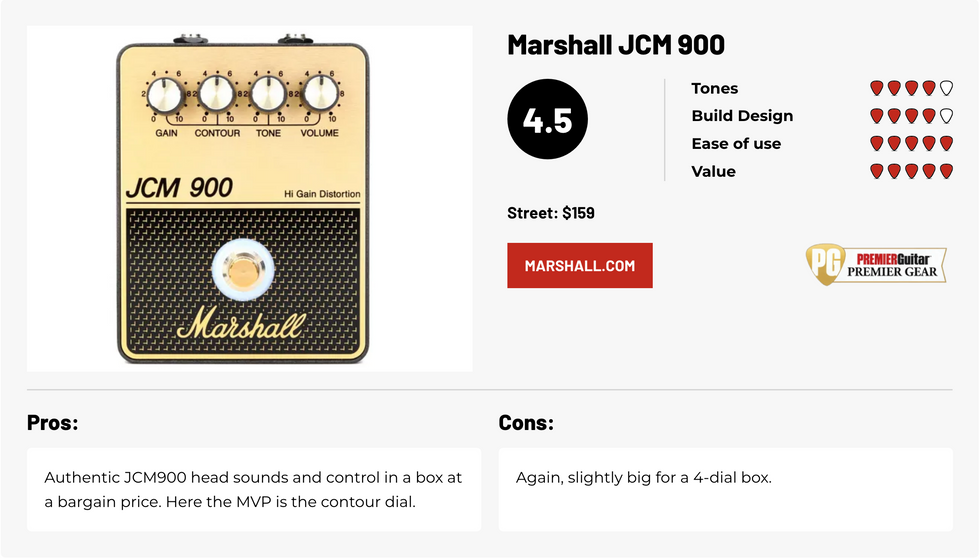
DSL Dual Super Lead Distortion
Introduced in 1997, the Marshall DSL, or Dual Super Lead, was designed to be a 2-channel Clydesdale. It’s the amp that embraces the widest spread of classic Marshall tones. Its vocabulary nods to all its heavyweight predecessors, and it’s capable of sounds that are clean and ringing as well as gnarly distortion. That versatility makes it a good partner for just about any style except folk music, unless you like your folk with a lotta attitude. (On the jazz side, Sonny Sharrock, who was a JCM800 player, would have dug this amp, too.)
This pedal is patterned on the amp’s second channel, which gleefully leans into higher gain and distortion levels. Setting the dials—gain, deep, tone, and volume—at 11, 10, noon, and 3 o’clock respectively delivered the sort of scalding, dirty rhythm sounds I associate with Pearl Jam. But turning the volume back a bit, I was reminded of a Fender Bassman with an overdrive pedal in front. In fact, on all these pedals, volume and gain are satisfyingly interactive, just like the amps that serve as their foundation.
For the DSL stompbox, the deep dial also plays an important role in this sort of mimicry. It is a low-end boost, which is especially valuable at quieter volumes, adding, well, depth, as advertised. Between the depth and tone control, the pedal offers a wide range of sonic character. And, of course, with the gain floored, it burns.
Playing through Marshal’s JVM, JCM800, JCM900, and DSL Pedals was an absolute delight, like having a fleet of toothy, world-class amps at my disposal. And they come at a bargain price. I recommend treating yourself to your own test flight as soon as possible.Ratings
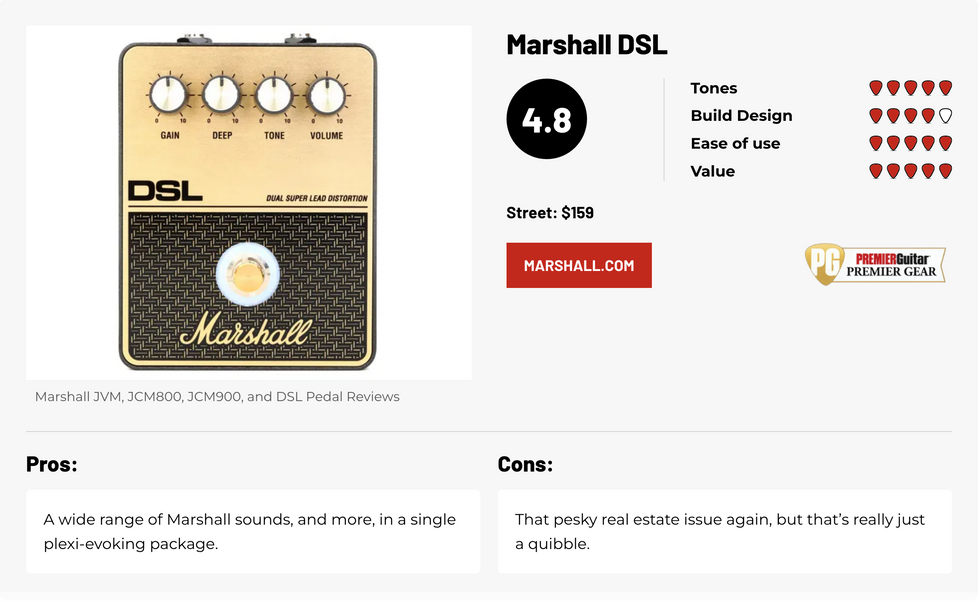
Marshall JVM, JCM800, JCM900, and DSL Pedal Reviews

Marshall enters the amp-in-a-box ring with a series of true heavyweights that punch hard but can also dial back.
If you’d like to own a stable of classic Marshall heads but your budget won’t say “yes,” the legendary UK company may have a solution in the form of their recent line of amp-in-a-box overdrive pedals. They’ve put five of their greatest hits—the Super Lead (reviewed separately in our July issue), the JCM900, JCM800, the DSL, and the JVM—in 5" x 4" x 1 1/2" stomps, with a black-and-gold panel-and-grille-cloth motif. Sonically, they range from “nailed-it” to stunning. And at $159, all four total less than the tab for a 100-watt DSL head and just a bit more than the 20-watt version, to say nothing of the $2,899 it takes to grab a new JCM800. With this snarling, all-analog, true-bypass quintet, all you need is a solid pedal-platform amp and a humbucking or single-coil 6-string, and you’re in business.
Admittedly, my test amps were very solid: a Carr Vincent and the company’s Telstar. But I also have extensive experience with 800s and Super Leads, and I know a good time when I hear it. Whether spanking a PRS SE Silver Sky, a ’68 Les Paul Standard, a custom Zuzu with coil-splitting, or a been-through-Hell Tele with humbuckers, the results are gritty and sparkling, with rich midrange tones and plenty of articulate brightness in these pedals’ simple controls. And while these creations take a standard barrel-pin connector, they also run on 9-volt batteries, which makes them an easy drop-and-go asset for backline gigs.
JVM Distortion & Noise Gate
Generally, I’m a low-to-medium gain player…until I plug into a Marshall. At club and practice room volumes, I like to crank the gain all the way, use the master to set my level, and then adjust the tones with a prejudice toward floored mids, or close to that, and highs somewhere around 2 or 3 o’clock, depending on the amp and guitar combination. This modus operandi paid off immediately with the JVM. In fact, it was a rewarding strategy for each of these pedals.
What’s appealing to guitarists like Joe Satriani about JVM heads is their blend of controllability, touch response, grit, warm midrange, and singing sustain. The JVM has its grounding in the kind of classic Marshall tones initially made by the Super Lead, but with extra sizzle and snap via a lot of smooth, highly controllable, well-balanced gain.
Strapping in for a flight with all these pedals is the very definition of plug and play. The JVM has just four dials: volume, tone, gate, and gain. The gate is perfectly effective. If you’re cranking the gain, just dial up the gate until the hiss disappears. And unlike many gates, it leaves your core tone shining. The tone control has range enough that the amp’s 3-band EQ is not missed (at least by me). And while the pedal can get very loud, rolling back the gain to noon-ish and peeling off the gate creates nice low-gain-amp tones not typically associated with JVM heads. That makes this pedal a joy to play and, whether you’re a high-gain or low-gain partisan, gives it the potential to lead you to tonal places outside your usual wheelhouse.
Ratings

JCM800 Lead Series
This is a pedal version of Marshall’s flagship ’80s head that helped produce many of that decade’s defining guitar voices—most notably, perhaps, Slash’s. Like the other boxes in Marshall’s new silicon-based overdrive stomp series, it rekindles those voices admirably. Its overall sound is a little looser than the JVM pedal, with a somewhat darker character, which might make it an appealing Marshall gateway for players who typically go low-gain but yearn for a taste of the wild side.
The JCM800 has plenty of controllability and volume in its 4-dial setup. Here, the knobs are gain, volume, and tone, naturally, with the addition of sensitivity. Sensitivity isn’t the same as presence, which boosts upper-midrange and treble frequencies. Instead, the sensitivity dial controls the amount of signal that goes into the preamp stage of an amp. The higher it’s turned, the more tube saturation and gain. (In older Marshalls, this aspect of tone coloration was often accessed by jumping the high and low inputs of amps like the Super Lead with a short cable.)
Keep both this dial, which emulates that process, and the gain low, and the JCM800 pedal takes a softer route, with less growl and a looser response to your fingertips and picking. Turn it up and the sound becomes nasty and more harmonically rich and reactive. In my opinion (and I toured with a JCM800 for years), these amps and this pedal have a buzzing quality in their sonic character until the gain is pushed to 2 or 3 o’clock, the tone past noon, and, in the pedal’s case, the sensitivity moves to about 2 o’clock. At these settings, the volume needs to rise to about 10 o’clock or better for the tone to open up, and that’s really pushing it in smaller rooms. But there are some great voices in the blend, and setting sensitivity to 10 o’clock, cranking the gain all the way, moving the tone to 1 or 2 o’clock, and the volume to 3 or so delivers lovely hard-rock crunch. Of course, that’s all subjective and influenced by what amp you’re pushing these pedals through, so the best test, as always, is firing one up for yourself.
Ratings

JCM900 Hi Gain Distortion
To my ears (and fingers), JCM900 heads have a tighter sound and are more responsive to your hands than 800s. I got the same impression playing this pedal too, which makes the JCM900 more genre-flexible, in my book. The secret sauce in this stompbox is administered via the contour control, which joins the gain, tone, and volume dials. Turn it down and the mids become scooped; turn it up and they are pushed to the fore.
This box is capable of tight ’80s and ’90s rhythm sounds, with the gain at 3, contour at 6, tone straight up, and the volume wherever makes you happy. Overall the tones are sparkling and snappy. Push the contour higher and mid-heavy lead sounds soar out, especially with the tone past 2 or 6 o’clock. This territory is blues-rock paradise. But my favorite setting was with the gain full-on (of course), the contour and tone around 1 o’clock, and the volume at 11 o’clock, crafting a blend of tough, biting, and sweet. I didn’t find the JCM 900 as versatile as the JVM or DSL pedals, but it’s nonetheless a charmer and, depending on your palate, may be perfect for your tastes.
Ratings

DSL Dual Super Lead Distortion
Introduced in 1997, the Marshall DSL, or Dual Super Lead, was designed to be a 2-channel Clydesdale. It’s the amp that embraces the widest spread of classic Marshall tones. Its vocabulary nods to all its heavyweight predecessors, and it’s capable of sounds that are clean and ringing as well as gnarly distortion. That versatility makes it a good partner for just about any style except folk music, unless you like your folk with a lotta attitude. (On the jazz side, Sonny Sharrock, who was a JCM800 player, would have dug this amp, too.)
This pedal is patterned on the amp’s second channel, which gleefully leans into higher gain and distortion levels. Setting the dials—gain, deep, tone, and volume—at 11, 10, noon, and 3 o’clock respectively delivered the sort of scalding, dirty rhythm sounds I associate with Pearl Jam. But turning the volume back a bit, I was reminded of a Fender Bassman with an overdrive pedal in front. In fact, on all these pedals, volume and gain are satisfyingly interactive, just like the amps that serve as their foundation.
For the DSL stompbox, the deep dial also plays an important role in this sort of mimicry. It is a low-end boost, which is especially valuable at quieter volumes, adding, well, depth, as advertised. Between the depth and tone control, the pedal offers a wide range of sonic character. And, of course, with the gain floored, it burns.
Playing through Marshal’s JVM, JCM800, JCM900, and DSL Pedals was an absolute delight, like having a fleet of toothy, world-class amps at my disposal. And they come at a bargain price. I recommend treating yourself to your own test flight as soon as possible.Ratings

Gibson Tones, Epiphone Price: The 1960 Les Paul Special Double Cut Demo
Raw, rowdy, rugged, and won’t break the bank—a no-frills double cutaway delivers on its decades-old streamlined design promise with USA-made P-90s.
The Gibson Les Paul Special was first introduced as a single cutaway model in 1955, and with the exception of the sunburst Standards that were produced from 1958-1960, it was the last of the original50s-era Les Paul model variants to be introduced. An enhanced version of the Les Paul Junior with increased sonic flexibility, it featured two P-90 pickups instead of the single P-90 found on the Junior and also added a bit of extra bling in the form of a bound fretboard and a mother-of-pearl headstock logo. In 1958, the body shape was revised from a single cutaway to a double cutaway, which delivered improved fretboard access, and the Special hit its stride in 1960 when a thinner SlimTaper neck profile and a lower neck pickup placement made it more robust and easier to play than ever.
Now, Epiphone, in partnership with Gibson Custom, is proud to introduce the 1960 Les Paul Special Double Cut Reissue, an Inspired by Gibson Custom recreation of the sought-after 1960 Les Paul Special Double Cut. Like the originals, it features a slab mahogany body with double cutaways that provide excellent access to the entire length of the fretboard. The one-piece mahogany neck has a fast-playing 60s SlimTaper profile and is capped with a rosewood fretboard with 22 medium jumbo frets and mother-of-pearl dot position marker inlays. The fretboard has a 12” radius that makes playing first-position chords and solos with string bends further up the neck equally effortless. The Gibson “open book” style headstock is equipped with Epiphone Deluxe three-on-a-plate tuners with white buttons and a GraphTech nut to help keep the tuning nice and stable, while a historic style Wraparound bridge with intonation screws solidly anchors the strings at the other end and contributes to the excellent sustain that the Les Paul Special is famous for. A pair of USA-made P-90 Soap bar pickups from Gibson Custom that can go from sweet and clean to outright nasty and dirty-sounding are hand-wired to individual volume and tone controls with high-quality CTS potentiometers and Bumblebee paper-in-oil capacitors for authentic vintage tones that are sure to please even the most tone-conscious players.
The 1960 Les Paul Special Double Cut Reissue comes packaged in a vintage-style case with a brown exterior and pink plush interior that features Inspired by Gibson Custom graphics on the exterior. It all comes together to deliver a vintage playing and ownership experience at an accessible price that is special in every way.


